Table of contents
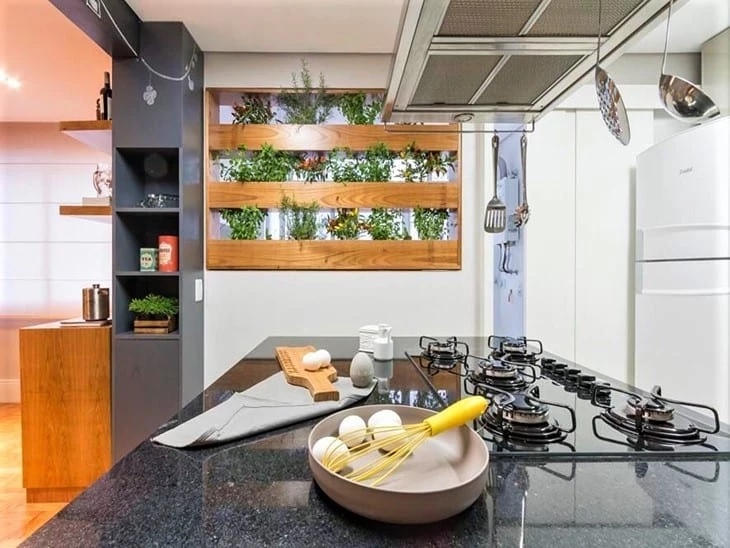
Those who enjoy cooking know that there is nothing better than using fresh and healthy food, especially when it comes to seasonings and herbs. After all, very fresh seasonings make food taste much better.
A good alternative to ensure this freshness and quality of ingredients is to have a kitchen garden. Yes, it is possible to grow natural vegetables and spices in the kitchen in a simple and practical way, even in small spaces.charming with the aroma and beauty of plants.
Besides the most common vegetables - such as parsley, chives, rosemary, mint, basil, oregano, and thyme - it is also possible to grow larger spices in the kitchen, such as peppers, and even some smaller fruits, such as strawberries, for example.
Why have a kitchen garden in the kitchen?
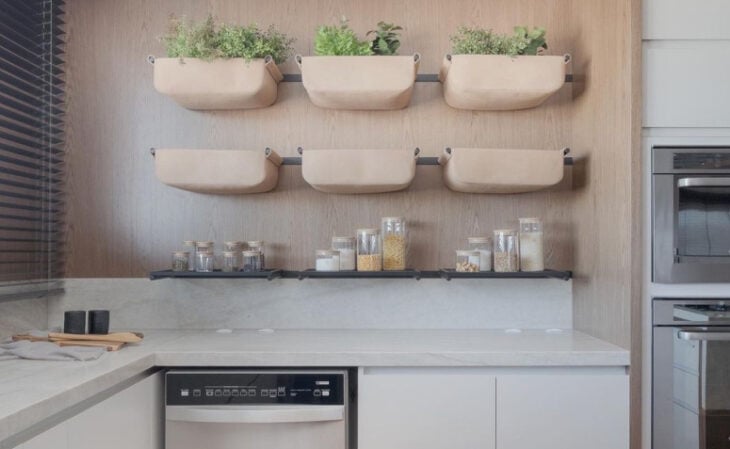
Horticulturist Brenda Pacheco, from Fazendo Horta, says that there are many benefits to having an organic garden and planting your own spices. Among them, we can mention:
- - More flavor in the foods grown;
- - Guarantee of food without the use of agro toxics;
- - Saving on supermarket expenses;
- - Improved diet due to the consumption of a greater variety of fresh vegetables;
- - Less waste, since it is possible to harvest only what is consumed at that moment;
- - Better relationship with nature, since you have to take care of the little plants and observe their growth.
Observing the slow growth of each plant makes us reflect on the rush of fast-food society and develop patience to wait for the harvest time", she explains.
Where to do it?
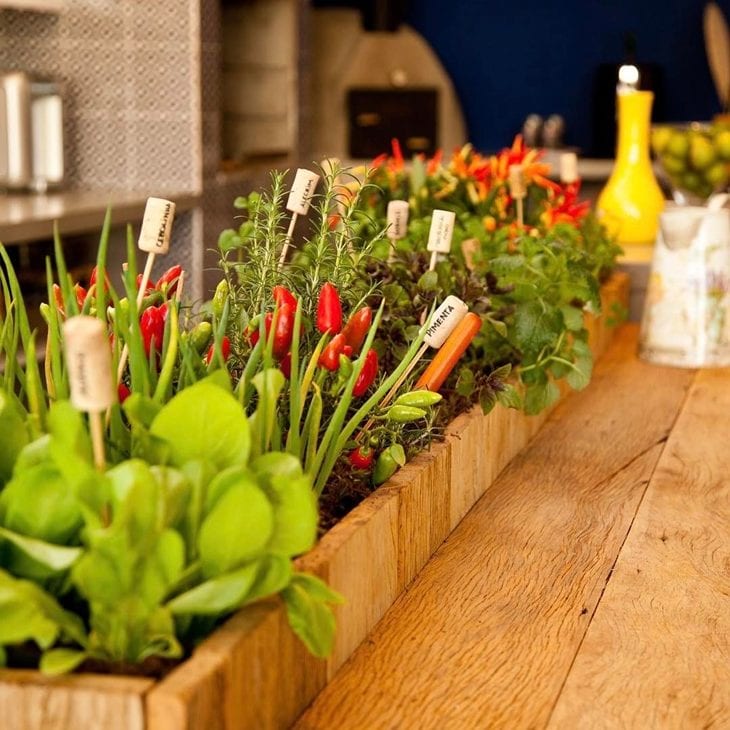
Those who have kitchens with larger spaces can use and abuse of creativity and set up larger gardens on countertops and panels, for example. However, apartments or houses with little space can also have a corner for planting a vegetable garden, just choose any of these alternatives:
- Vessels: The vases are practical alternatives both for those who live at home and for those who live in apartments. This option offers several options of sizes, materials, shapes and colors. One of the advantages of the vases is that they take up little space and can be placed in different places. In addition, they also work as great decorative elements.
- Recycled packaging: How about a sustainable option? You can plant your vegetable garden in PET bottles, soda and food cans, milk cartons, glass jars, and even eggshells. Besides caring for the environment, it is super cheap and easy to do.
- Flowerbeds: The planters can be made of masonry, wood, or metal and are great for a compact garden in small spaces. They also make the environment very charming.
See_also: 70 pictures of luxury living room that ooze charm and sophistication- Wooden boxes: Wooden crates and pallets are inexpensive choices and have a very adequate space for vegetable gardens. They go very well with more rustic settings.
- Mugs and jars: Glass or plastic mugs and jars can also be used to plant your vegetables, as you can take advantage of objects that you already have at home. Just be aware of the care that you must take with the plants in this case, especially in relation to the accumulation of water, since these containers do not have holes.
- Vertical garden: This type of vegetable garden is the darling of the moment, because besides optimizing the space, they cause an incredible effect on the decoration. The vertical vegetable garden consists in setting up the garden taking advantage of the spaces next to the walls. It can be planted in different containers, such as pots, recycled packaging, wooden structures, and shoe racks. For those who live in apartments, this is one of the best solutions.
How to assemble your vegetable garden - step by step
Do you want to know exactly how to grow your kitchen garden? Follow Brenda's recommendations step by step so that you don't make a mistake in the process:
Step 1: Study and analyze the ideal location
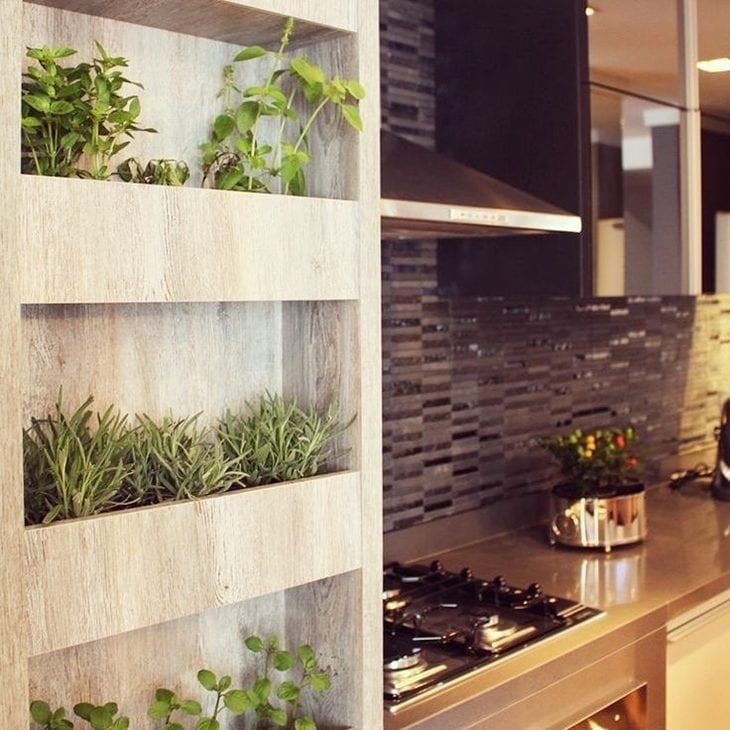
The first step is to choose the ideal place in the kitchen to set up the vegetable garden: "Choose a well-aired place with good lighting. Give preference to places that receive at least three hours of sunlight a day," says Brenda.
Therefore, observe well the available corners of your kitchen and choose the most airy and illuminated, remembering that the incidence of the morning sun is even better. It is indispensable for the plant to survive, so never opt for dark places and don't count on the help of artificial lighting. It is also worth remembering that the incidence of light can change, and the garden needs to follow the brightness. Attentionto the changing incidence of the sun throughout the year, and move them if necessary.
It is also important that the place has little humidity and that it does not receive strong winds, as this can harm some plants. Another nice tip is to install your vegetable garden in a corner with which you have a lot of contact, respecting, of course, the adequate light and ventilation conditions. This way, it will always be visible and you will be able to better care for and follow the growth of the plant.
Step 2: Choose the vegetables
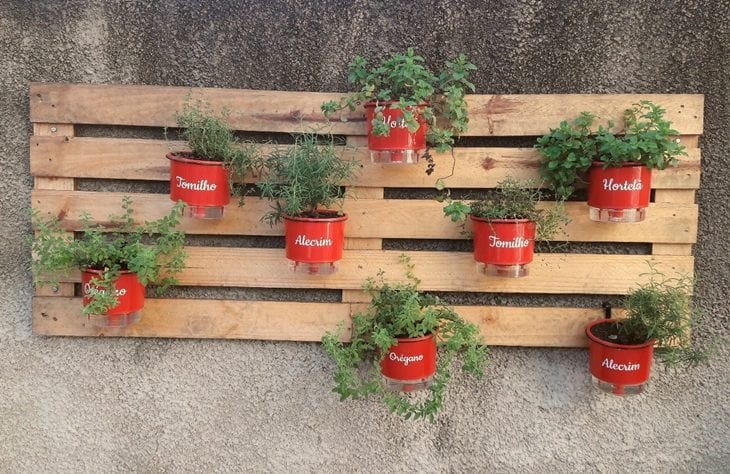
After you have found the ideal place to install your vegetable garden, the next step is even easier: choose which vegetables and spices you want to plant. About this, Brenda explains: "we can plant any kind of spices at home. We usually guide our customers to choose what to plant according to what the family likes to consume, having in mind the place available forto shelter the little plants".
So take a few minutes and ask yourself which spices will be most useful for you when cooking and which condiments you and your family like best. Then get to work!
Step 3: Choose the right pot
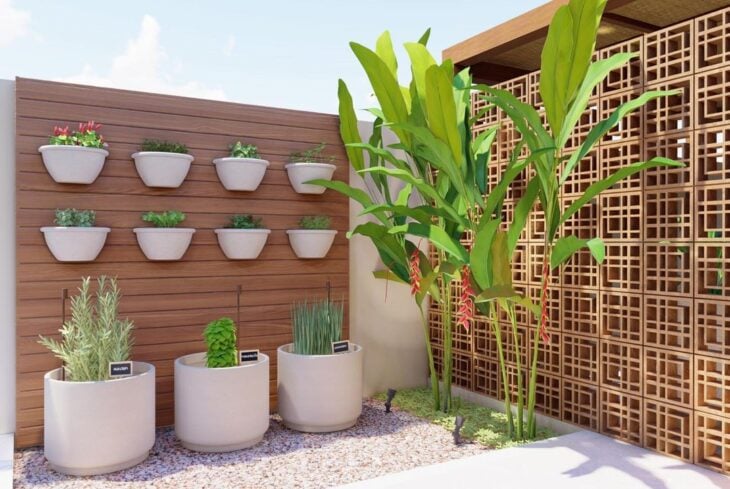
This step is very important, because it is necessary to pay attention to some details before choosing the best container to plant your vegetables. As we have seen previously, any place can be used for planting: cans, mugs, pots, cachepots, planters and planters, but Brenda explains that the right pot depends on the size of the plants.The smaller the pot, the smaller the space for its roots, and this directly impacts the growth it will have and its productivity.
Brenda also explains that to keep a plant in a small pot, one must have a routine of root pruning, as is done with Bonsais: "A simple rule that we can apply to have a plant with normal size and good productivity is to plant in a pot that has the depth of about 2/3 of the size of the adult plant", guides the professional. The horticulturist teaches what is the depthideal for pots of the following spices:
- Chives: pot depth about 16 cm.
See_also: Living room blinds: 50 beautifully decorated rooms to inspire you- Parsley: depth of the pot about 12 cm.
- Basil: Pot depth about 26 cm.
- Oregano: Pot depth about 15 cm.
It is also worth pointing out that those who choose pots, jars, boxes, and bottles, whether in vertical or horizontal gardens, should not forget to provide holes in the bottom to avoid excess water in the soil. Drainage containers, i.e. those that do not accumulate too much water, are always the best options.
Step 4: Use good quality soil and seeds
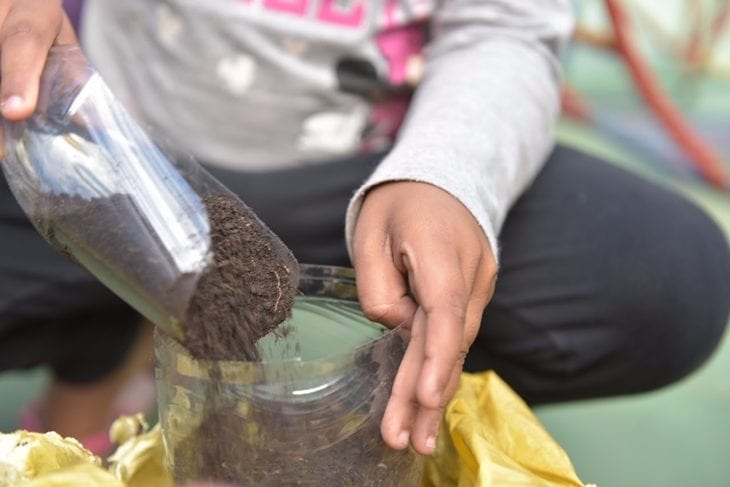
The preparation of the soil is a very important step for your garden to work well, since it is from the soil that the plants will acquire the necessary nutrients to grow in a healthy way: "It is essential that you use a good quality soil, because that is what the plant will 'feed' on. Irrigate at least four times a week or use self-watering pots", teaches Brenda.
There are different ways to prepare soil with a good amount of nutrients, but you can buy prepared soil from specialty stores. This can be a great alternative to ensure adequate soil for the growth of the plants in your garden, since this type of product comes ready prepared with the necessary nutrients.
However, it is essential to check the packaging and the recommendations for use before you start planting. On the label of the bag of soil, it should state that it is intended for growing vegetable gardens and vegetables. Do not use soil prepared for flower and garden cultivation, as it is not properly fertilized and the development of the vegetables may be harmed.
Another relevant information is that vegetables and spices can be planted as seedlings or seeds, and before planting them, it is important to check their quality and health. Choose good organic seedlings and seeds, without defensives and synthetic fertilizers. If you plant seedlings, always check the condition of the plant, making sure it is healthy, so as not to run the risk of starting the cultivationThe seedlings should be buried at least 15 centimeters deep and at least 20 cm apart for each type of vegetable or spice.
Tips and care
Besides following the step by step instructions, it is necessary to take some care with the garden to keep it healthy. Check out some more of Brenda's tips that can help to further improve the quality and development of your home garden:
Different vegetables in the same pot
 Before planting different vegetables in the same pot, you need to know if they actually work together. According to Brenda, each plant has its own life cycle characteristics, from the preferential time of planting, the need for water and nutritional requirements. For example, there are short cycle plants such as lettuce, eggplant, tomatoes and radish, and short cycle plants such as lettuce, eggplant, tomato and radish.Many species can be associated with each other, as they favor each other: besides a better use of space, the intercropping encourages the growth and protection of the species against pests, and helps maintain soil fertility," she explains.
Before planting different vegetables in the same pot, you need to know if they actually work together. According to Brenda, each plant has its own life cycle characteristics, from the preferential time of planting, the need for water and nutritional requirements. For example, there are short cycle plants such as lettuce, eggplant, tomatoes and radish, and short cycle plants such as lettuce, eggplant, tomato and radish.Many species can be associated with each other, as they favor each other: besides a better use of space, the intercropping encourages the growth and protection of the species against pests, and helps maintain soil fertility," she explains.
However, for this practice to work, the horticulturist says that it is worthwhile combining plants with different cycles (short and long): tomato + basil + lettuce + eggplant. Rosemary, basil, oregano, pepper, and thyme can also be grown together, while mint should be grown alone.
"One question we are always asked is whether we can plant parsley and chives together. Although these herbs go well together in the dish, in the garden it is another story, because parsley is one of the herbs that does not like to share space with any other herbs. In other words, always choose to plant parsley alone, away from other vegetables," Brenda points out.
Irrigation and water quantity
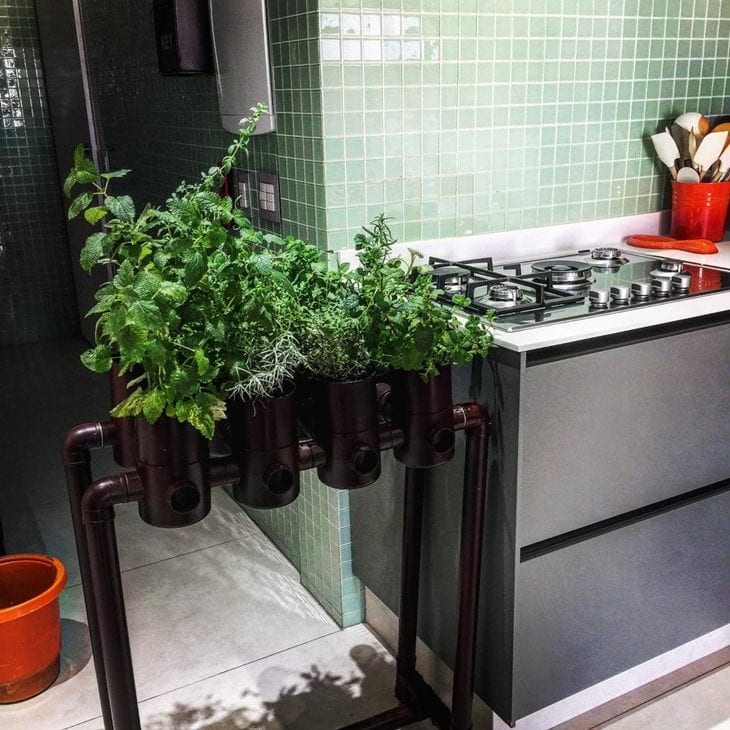 Brenda explains that each species requires a specific amount of water: "As a general rule, water four times a week or give preference to self-watering pots. Tip: the best time to water your vegetable garden is in the morning, before 10 a.m. or in the late afternoon, after 3:30 p.m. These times are ideal, because there is no direct sunlight on the garden.
Brenda explains that each species requires a specific amount of water: "As a general rule, water four times a week or give preference to self-watering pots. Tip: the best time to water your vegetable garden is in the morning, before 10 a.m. or in the late afternoon, after 3:30 p.m. These times are ideal, because there is no direct sunlight on the garden.
You must irrigate the pots without letting water run underneath. Be very careful with excess water, which can cause root rot and soil leaching, taking the nutrients away. When watering, the tip is to direct the water close to the root and avoid pouring it directly on top of the plant. This way, besides the excess water, you will also avoid any disease that is already on the leavesAvoid watering the leaves of your vegetables, especially tomatoes, basil, and mint, to avoid the proliferation of fungus," reinforces Brenda.
A tip to check the need for water is to observe the appearance of the plant. yellowish, dry and fallen leaves can be signs of lack of water. another method of verification is to insert your finger or a toothpick into the soil: if when you remove them, the soil is still wet; otherwise, it is time to water again. keep in mind that potted gardens tend to dry outquicker than in flowerbeds.
Fertilization

Vegetables require a well-nourished soil, so in addition to the previously prepared soil, after the plants are growing it is also necessary to do complementary fertilization. Keeping the garden soil rich in nutrients through fertilization will help to form more beautiful and well-developed plants.
"If you have a pet, you feed it at least three times a day, right? Your plants also need to be fed, because over time, the nutrients in the soil are consumed by it or taken away by the water, so to keep your plant well nourished, fertilize it once a month with organic fertilizer," says Brenda.
Organic fertilizer is the most indicated for planting. It is made of organic compounds such as chicken or cattle manure, humus and ammonium sulfate. Do not use chemical fertilizers, remember that the greater the variety of organic fertilizers used, the better for your health and also for the health of the plants. In addition, there are also some homemade solutions, such as coffee grounds and egg shells, whichcan be used as fertilizer on the plantation.
In addition to this care, after the harvest, the soil must also be fertilized before planting a new vegetable.
Prune
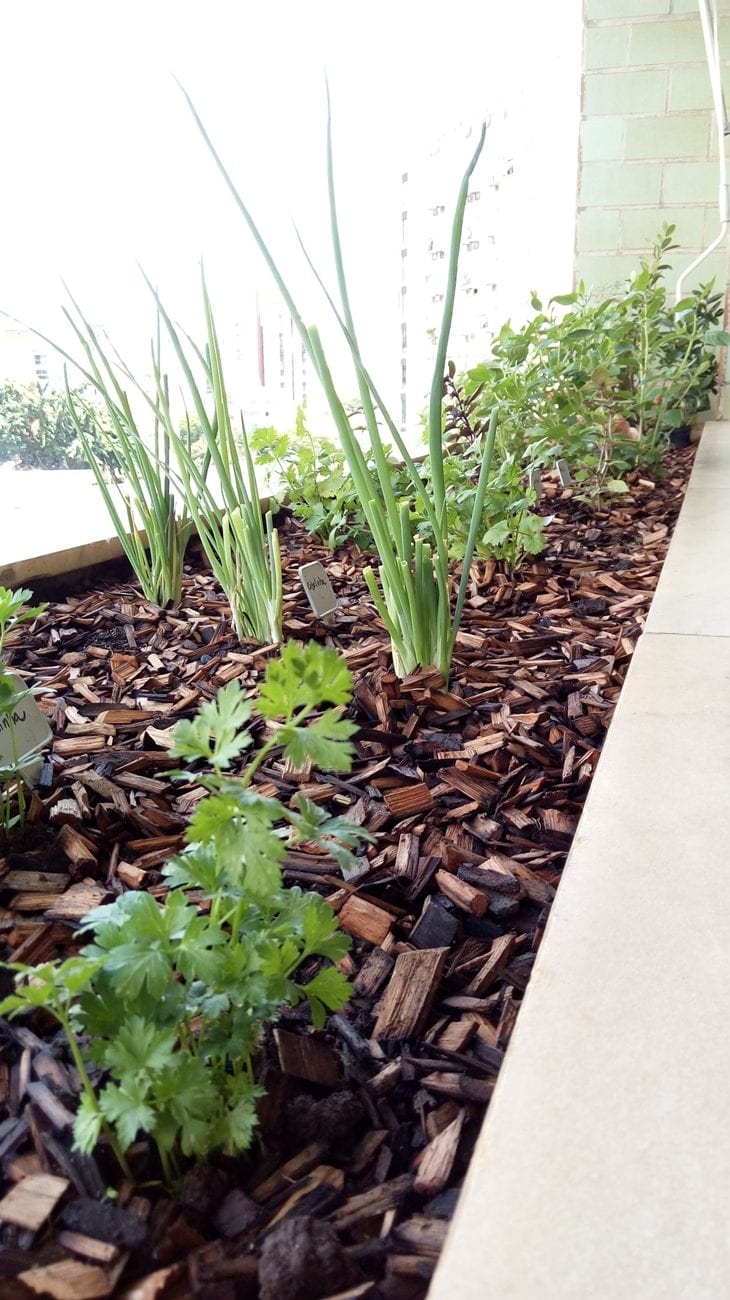 In relation to pruning frequency, Brenda reveals that the farmers, who according to her are the true holders of "green wisdom," use a precious tool to perform the stages of vegetable gardening: the influence of the phases of the moon. That is, they base their planning on the lunar chart to know the best time to sow, prune, and harvest.
In relation to pruning frequency, Brenda reveals that the farmers, who according to her are the true holders of "green wisdom," use a precious tool to perform the stages of vegetable gardening: the influence of the phases of the moon. That is, they base their planning on the lunar chart to know the best time to sow, prune, and harvest.
She explains: "For example, the best lunar phase for pruning and harvesting is the New Moon, at the beginning of flowering, which means that before the plant allocates much of its energy to flower formation, we prune the plants just below the 'node' where the flowers would be born, which helps to strengthen the plant from root to stem, since all its energy and nutrients are concentrated in this area.
The professional gives some more specific guidelines:
- - When it comes to seasons, the ideal months for pruning are autumn and winter (months without the letter "R").
- - Basil leaves should be picked from the top down. Its flowers are edible.
- - The lettuce leaves must be removed from the outside of the vegetable, preserving its center so that it can continue to sprout.
Harvest
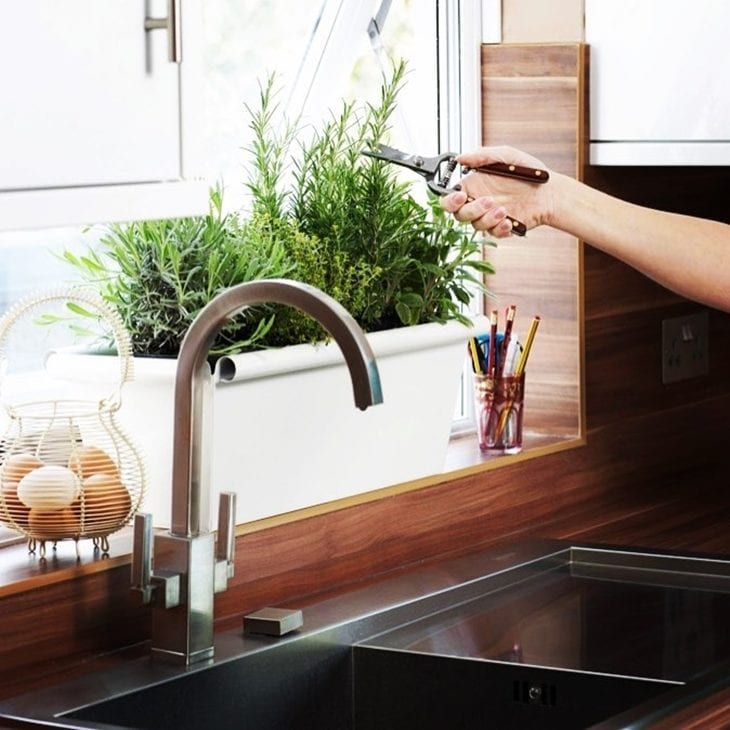 The time to harvest also generates many doubts, but it is important to know that it varies according to the species of plant and can be influenced by several factors, such as time of year, soil quality, nutrients, irrigation, eventual pests and other care in cultivation.Others, like the radish, have a single harvest, where the whole plant is removed to be consumed," explains Brenda.
The time to harvest also generates many doubts, but it is important to know that it varies according to the species of plant and can be influenced by several factors, such as time of year, soil quality, nutrients, irrigation, eventual pests and other care in cultivation.Others, like the radish, have a single harvest, where the whole plant is removed to be consumed," explains Brenda.
Usually on seed packets you will find the expected harvest indicated on the package, but this should not be a limiting factor in a home garden. For example, the plant does not need to be at its maximum development to start harvesting, you can harvest earlier. Harvesting before maximum development can provide some advantages, such as encouraging the plant to growmore, freeing up space for neighboring plants to grow, and, of course, faster consumption.
Pest Control
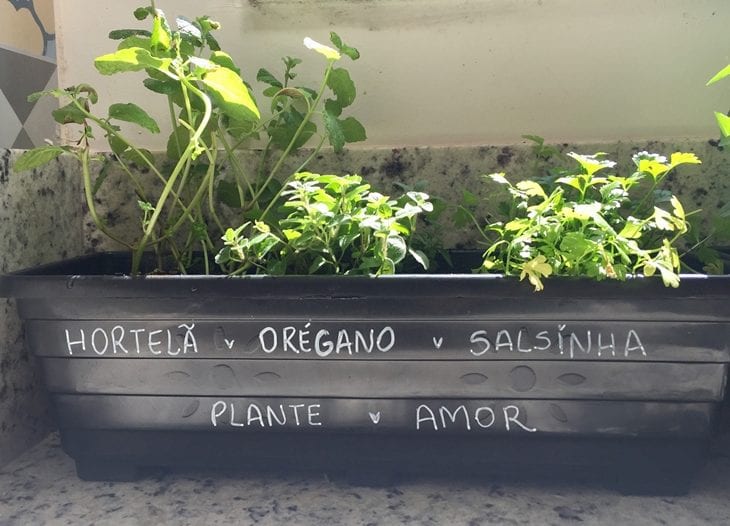
Even kitchen gardens are subject to pests, but the good news is that this happens less frequently and to a lesser extent than in larger gardens, so it is easier to control the problem and keep the plants healthy without much effort.
Pests in home gardens can be combated in a simple way. A good tip is to use mild soap, dishwashing detergent, or pepper and garlic extracts. Never use any industrial insecticide spray on the vegetables, as this can result in food poisoning, as well as being extremely harmful to both the plants and your health.
50 inspirations for kitchens with vegetable garden to help you make yours
After Brenda's great tips, now check out different kitchen garden models to inspire you even more to plant your own spices and organize them in a practical and creative way:
1. modern niche garden
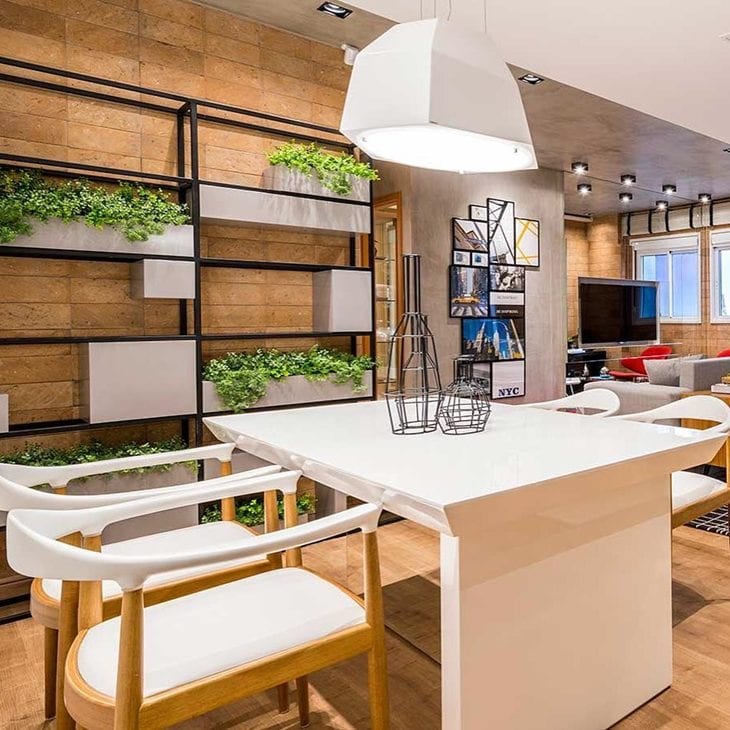
In this integrated kitchen, the vegetable garden was given a modern and creative corner: a metal shelf, with niches in lacquer with cachepots. The brick as a coating left the environment with a rustic touch, making a contrast with the more contemporary decoration.
2. vertical garden more than charming
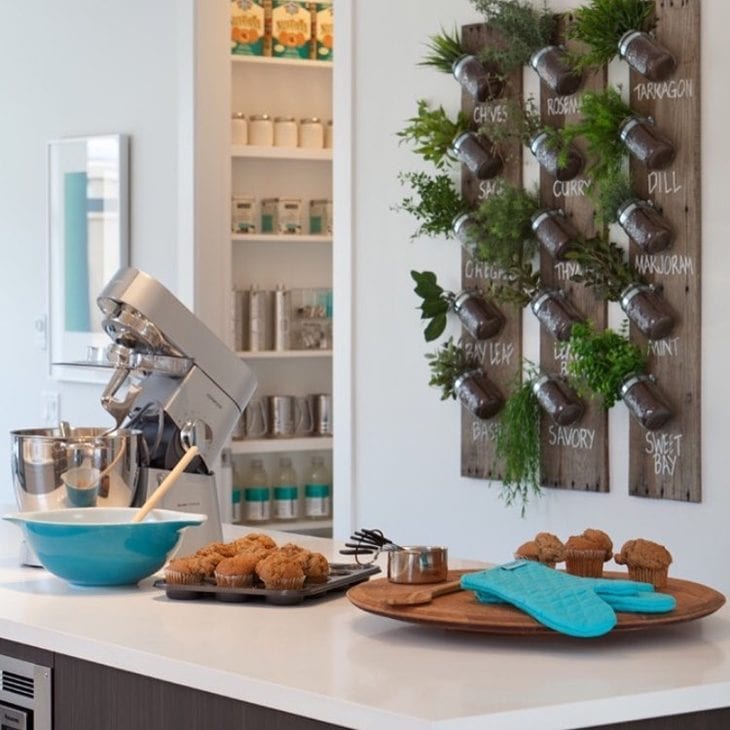
The vertical vegetable garden is an excellent way to optimize spaces. In this model, it was made with little glass pots attached to pieces of wood. Besides making the environment more beautiful, the wood also served to write the names of each spice. A beautiful vegetable garden for you to get inspired!
3. sometimes that touch of color has to be natural
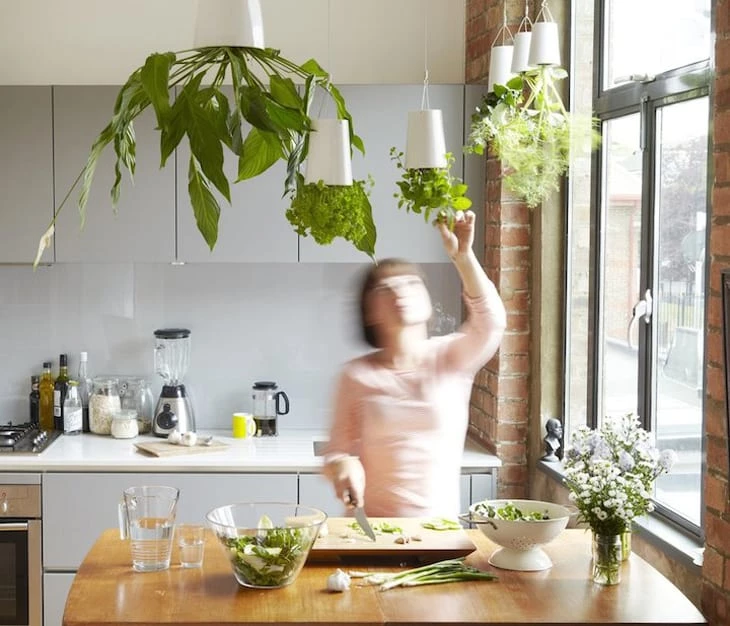
Here we see another example of a hanging vegetable garden, which is not only super practical, but also a great way to add color to the kitchen in a natural way. Instead of buying a lot of vegetables at the supermarket and letting them spoil because you can't consume everything, go to your own garden and harvest only what you will consume at that moment.
4. include the seeds in the decoration
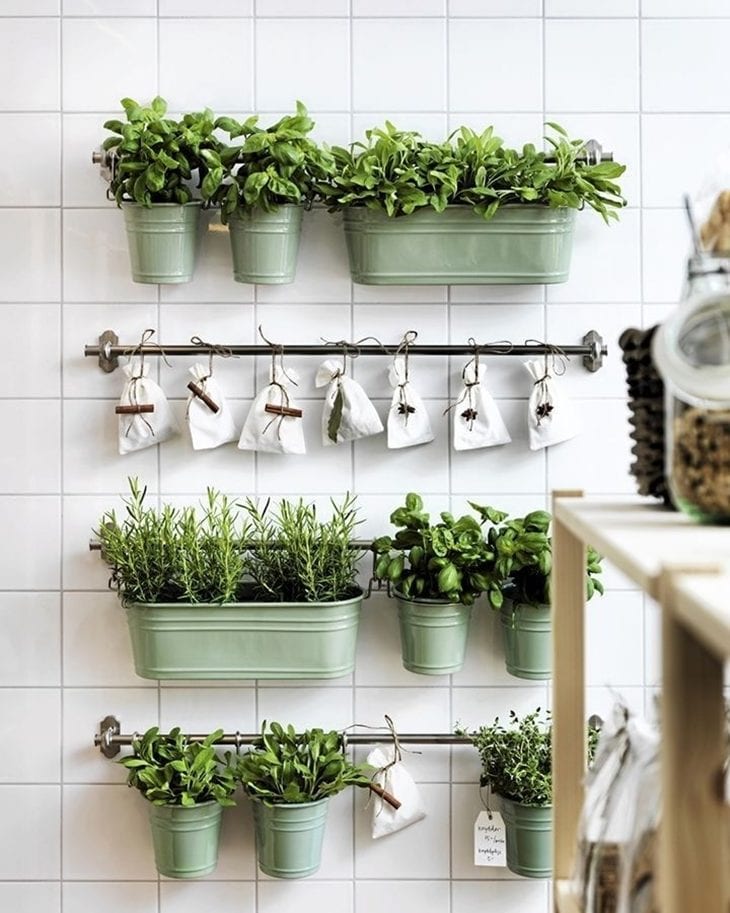
Nothing like having your spices fresh and at hand, isn't there? A kitchen garden, besides being beautiful, leaves the environment aromatized and you will always have fresh spices. And in this model, the idea is even more functional, because the seeds were also used in the decoration inside little bags hung together with the pots. Thus, after harvesting, the seeds are already there ready to beplanted again.
5. a portable vegetable garden
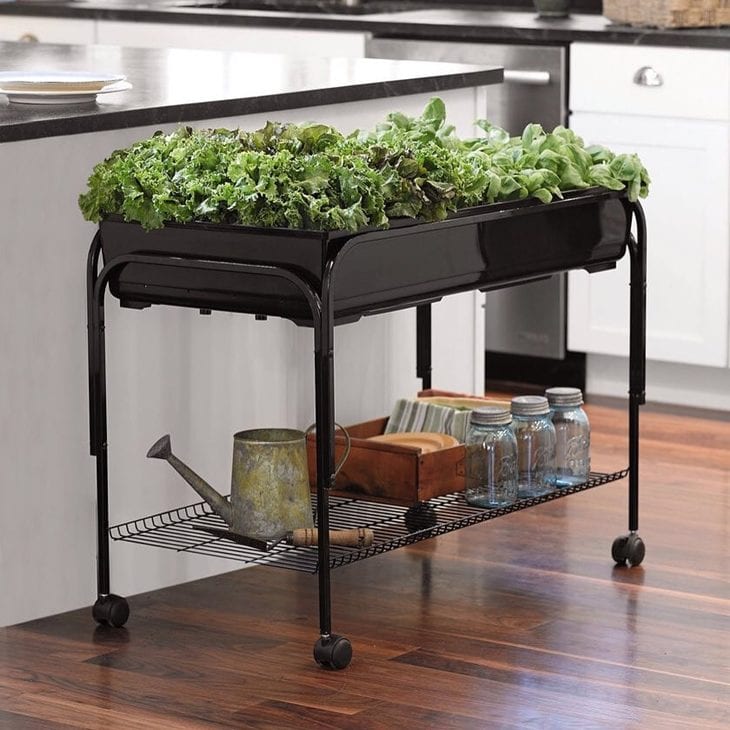
How about this model of vegetable garden on a portable shelf? This cart has gained a more than special function and made the decor much more authentic. The advantage of setting up the vegetable garden on this type of object is that it can be moved according to the incidence of light in the kitchen.
6. wall vegetable garden on shelves
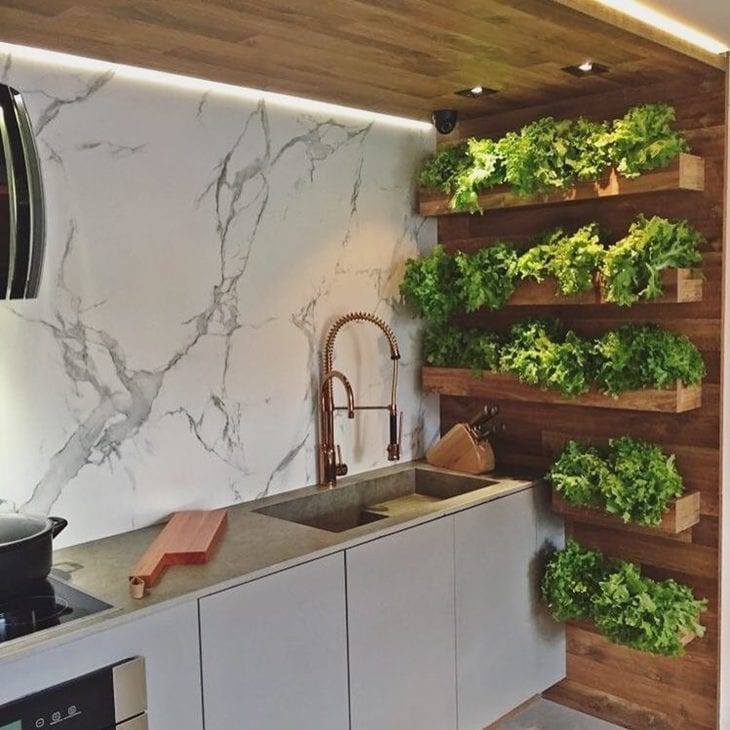
When you decide to have a kitchen garden in your kitchen, it is important to look for ideas to incorporate it without compromising the space, especially if your house is small. Here we see another model of vertical vegetable garden, only this time on beautiful shelves built into the wall.
7. mix vases with different designs
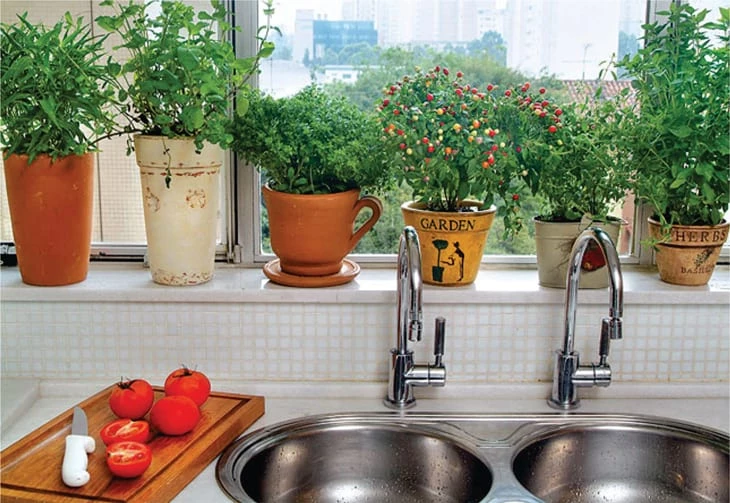
Mixing different pots for each type of spice in the garden causes a very interesting effect on the decoration. You can also mix the materials of the pots, for example, clay pots, plastic pots, ceramic pots, etc.
8. a solution with beauty and authenticity
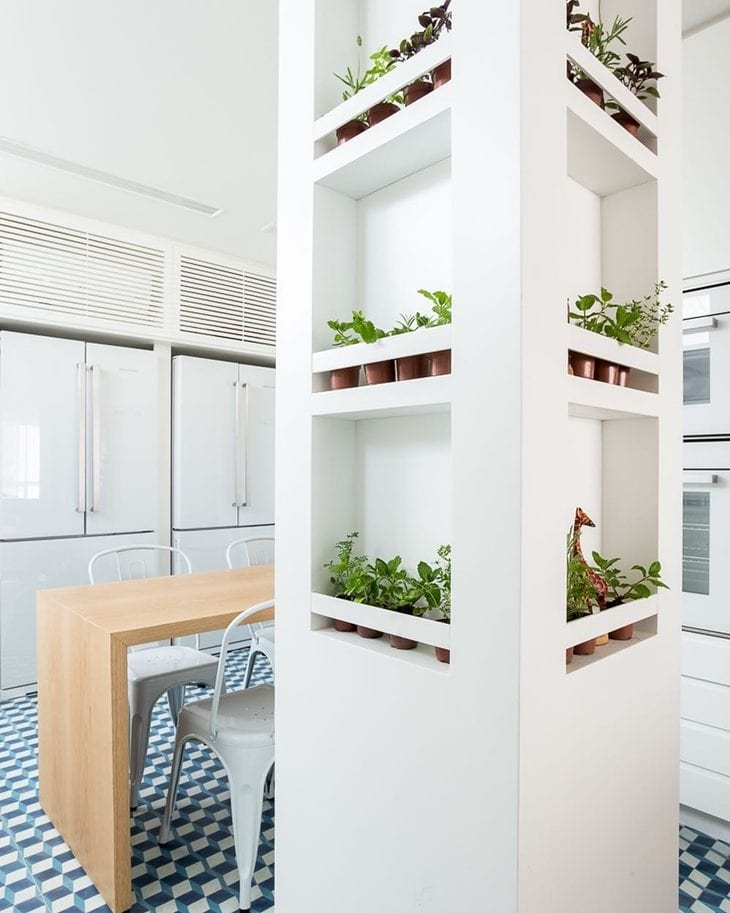
Here, we see an incredible and beautiful idea for small spaces. The existing piping was covered in woodwork to receive the spice garden. Thus, the environment became modern and the little plants gained a space dedicated just for them, being possible to position a good amount of vegetables.
9. beautiful wall vegetable garden set
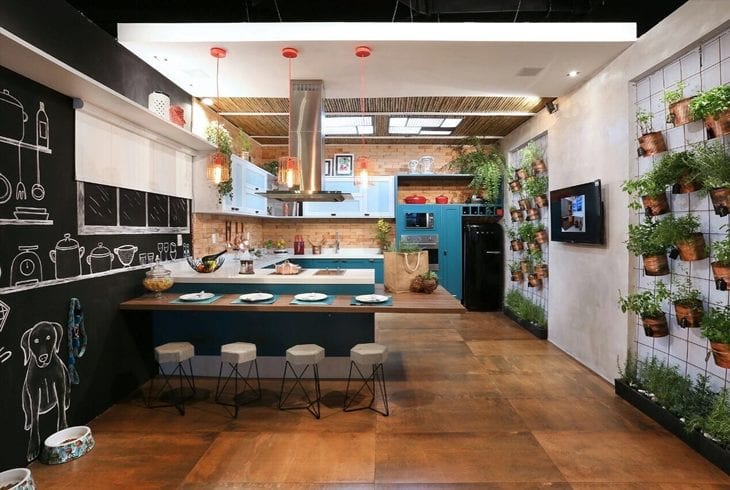
This large kitchen allowed a large amount of vegetables and spices to be placed in it. By growing vegetables, you avoid spending money on supermarket and market purchases. It is also an added asset in the decoration, since it is a way to add a touch of green and make the environment more fresh and welcoming.
10. small vases also work
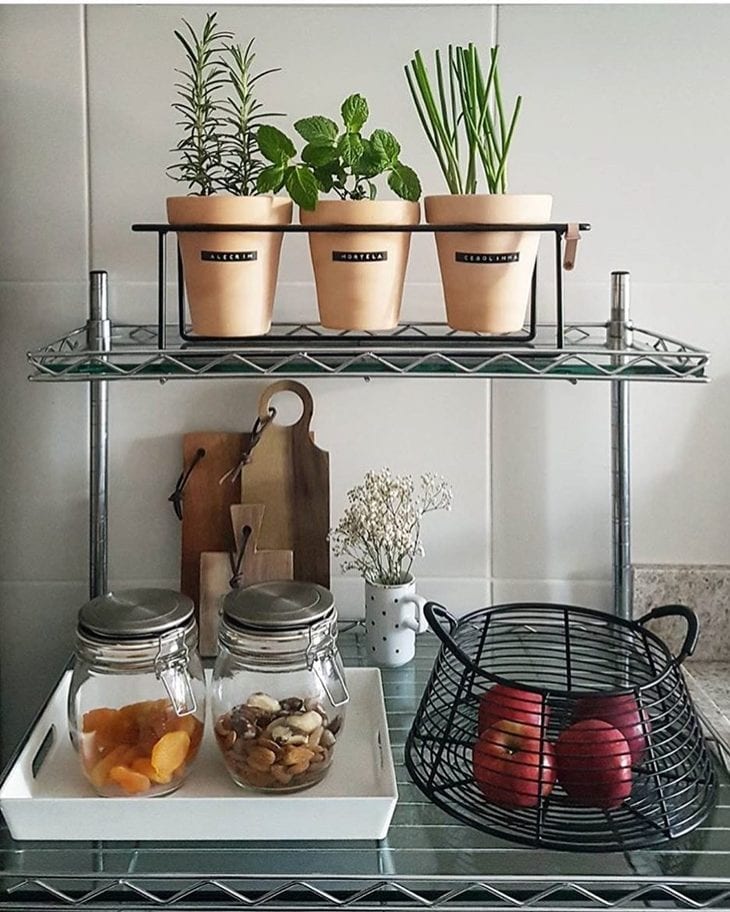
No matter where you live or how big your kitchen space is, you can have a vegetable garden anywhere, on the floor, on the wall, in pots, wherever your creativity (combined with the best conditions for the little plants) allows. These three pots made a beautiful composition with the other items on this shelf.
11. make your kitchen more beautiful and healthy
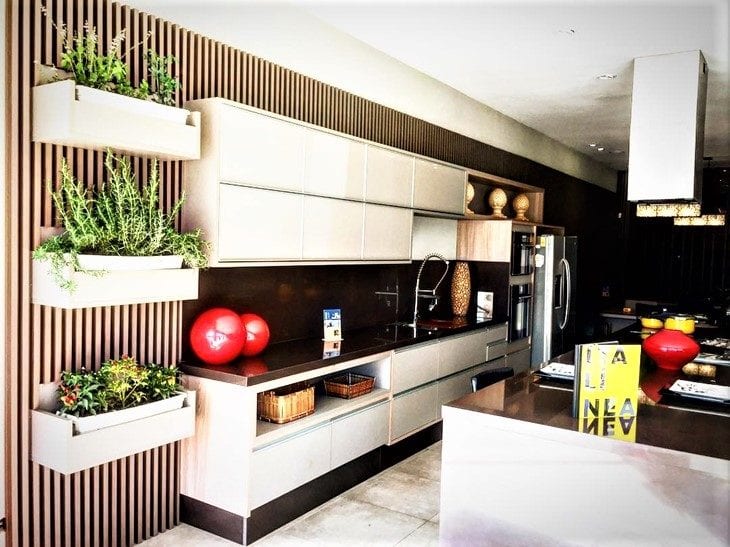
Having a vegetable garden at home is an added incentive to consume vegetables on a daily basis and should not be exclusive only to houses with spacious backyards. In this kitchen we see another option of shelves attached to the walls to receive the vegetable gardens.
12. practicality for the day to day
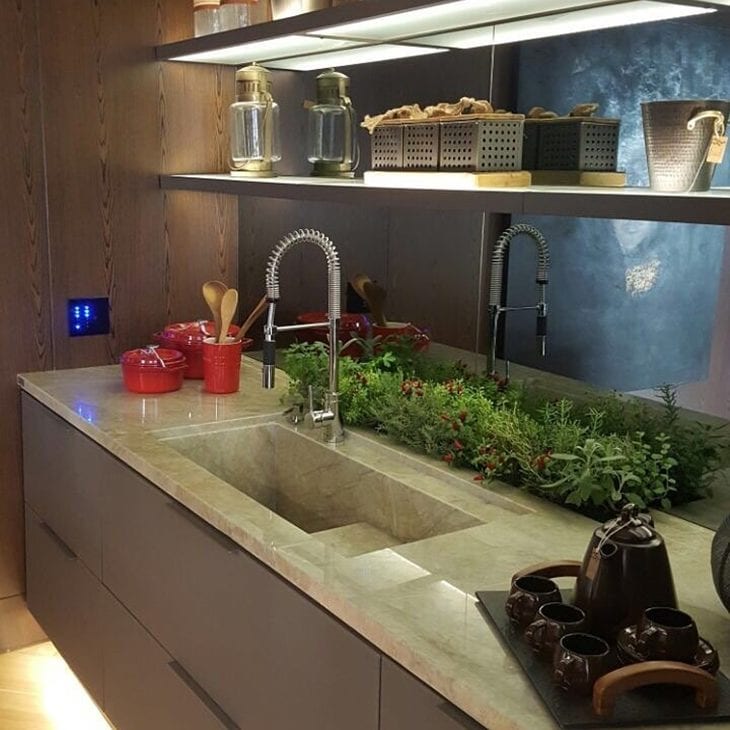
This vegetable garden on the countertop behind the sink is not only beautiful, but also very practical. It makes it super easy to harvest your spices and prepare food in a tastier and healthier way. Not to mention the beautiful composition you made with the countertop and the super modern and elegant faucet.
13. let your creativity flow

This mini vegetable garden was made with a lot of creativity. The wooden box looks cute as a space for the vegetable garden and is even more charming with the details in pebbles and for being placed in a suspended position. Not to mention the beautiful combination with the hydraulic tile on the wall.
14. have healthier and more economical meals
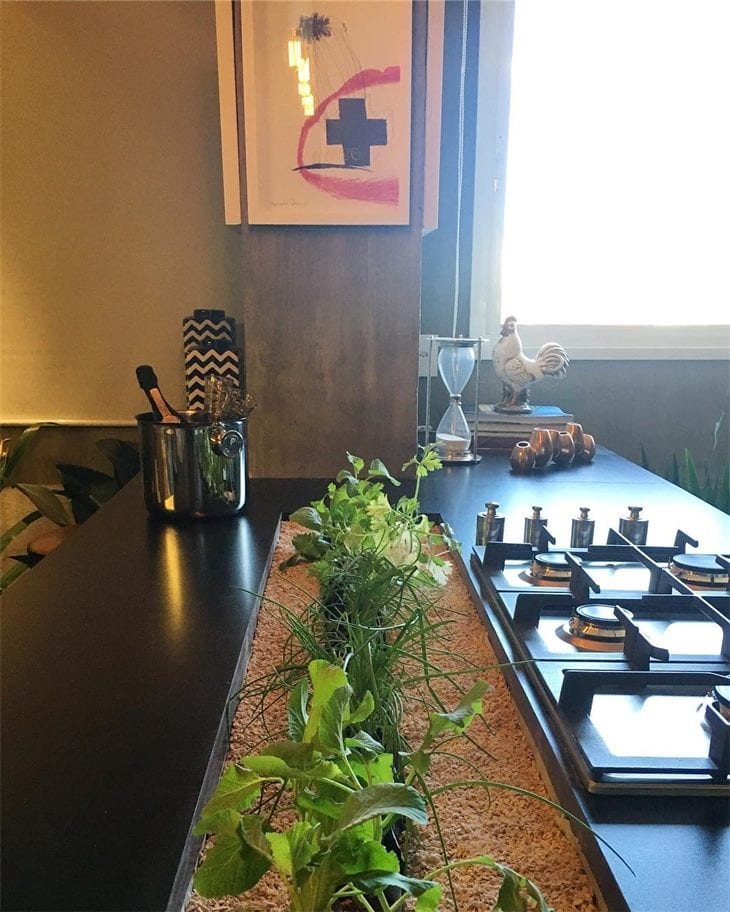
Another example that is pure practicality. Now, the vegetable garden is positioned right behind the cooktop. How about picking the spices for your lunch directly from your vegetable garden? Besides the health advantages, having a vegetable garden like this in the kitchen also brings benefits to your pocket.
15. beautiful modern gourmet kitchen

This beautiful gourmet kitchen is modern and stylish with an island and a built-in garbage can, but the most modern kitchen is the one with a beautiful, healthy and smelling vegetable garden.
16. don't forget the fruits
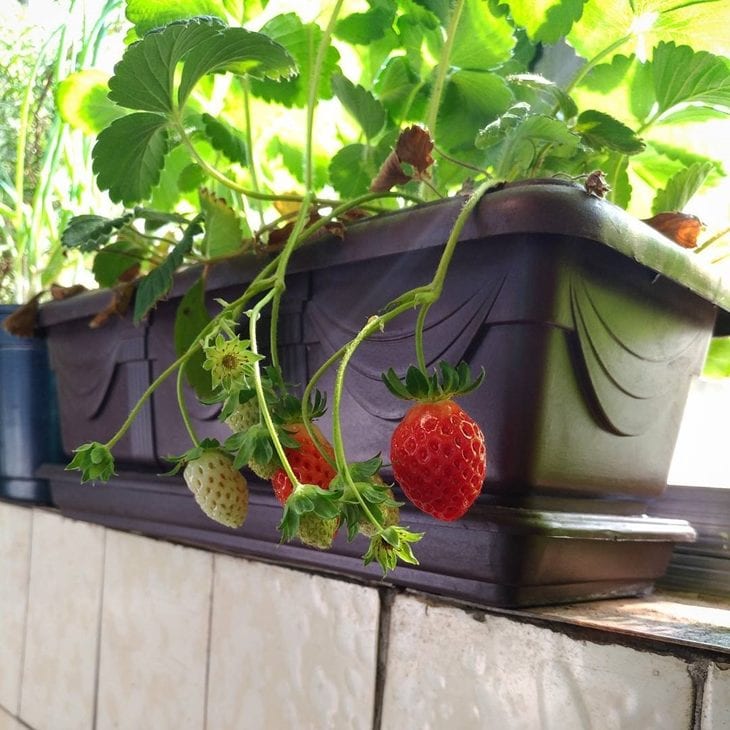
Small fruits can also be planted in kitchen gardens. Strawberries are a great option for home cultivation. Organic strawberries have a totally different flavor than the ones we are used to consuming, they have a much stronger taste and are always sweet. How about trying them?
17. a more industrial style
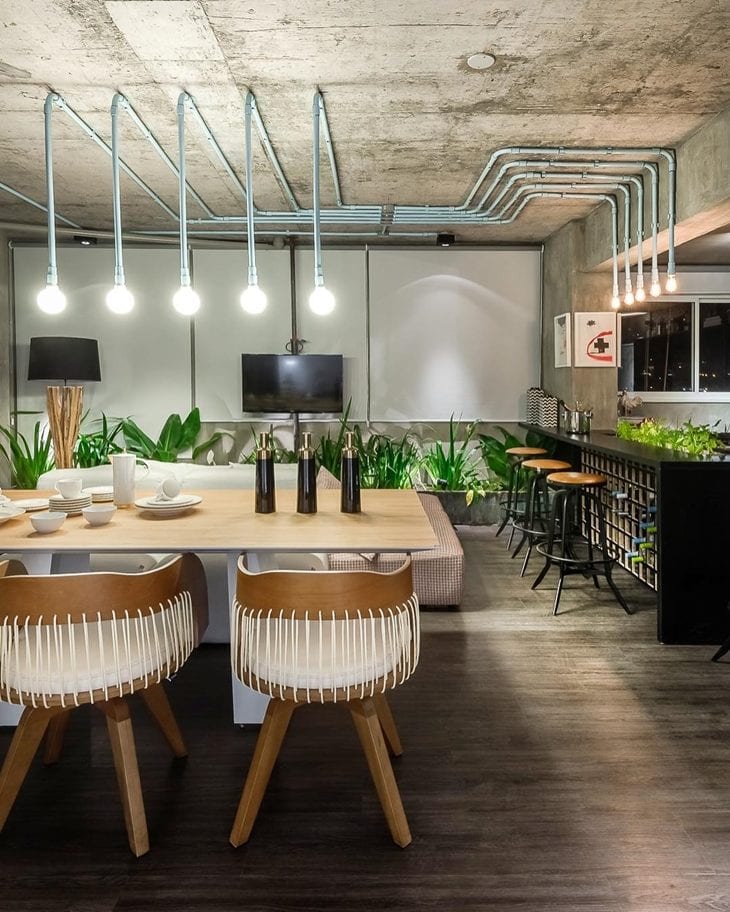
The industrial style with exposed pipes is very fashionable and has been used by architects in modern projects. This type of decoration also looks beautiful with a small garden, because it gives a touch of delicacy to the environment, making a counterpoint to the more aggressive air of this style.
18. the beauty of hanging gardens
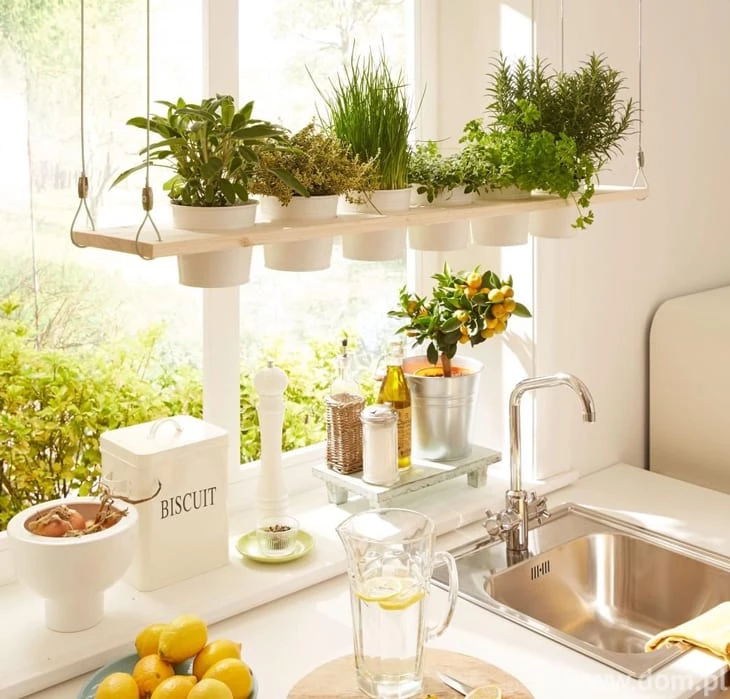
Do you want a vegetable garden in your kitchen but don't have the space? Look at this cool idea: a hanging vegetable garden! And on top of that, in front of the window, to get a lot of light and air. The spices will love it and your kitchen decor will be beautiful and charming!
19. clean kitchen with vegetables in small pots

As we have already seen, one of the simplest ways to grow spices is to start with small pots, which can be placed in the kitchen, on the countertop or on shelves. In this project, the ceramic pots make a beautiful composition with the cabinets and the white lacquered wooden countertop, enhancing the elegance and charm of the kitchen.lettuce.
20. use the garden to disguise elements
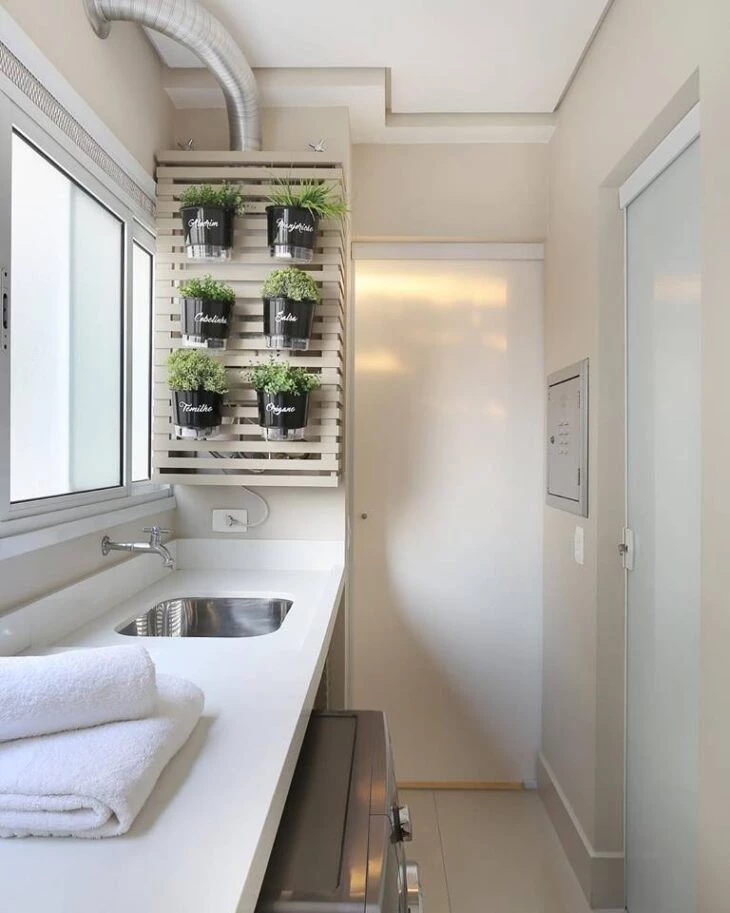
In this example, the vegetable garden also served to hide or at least disguise the gas in the kitchen integrated with the laundry room. A charming palette panel was used with pots attached and named for each spice. It is also a great solution for small spaces.
21. don't throw away the cans
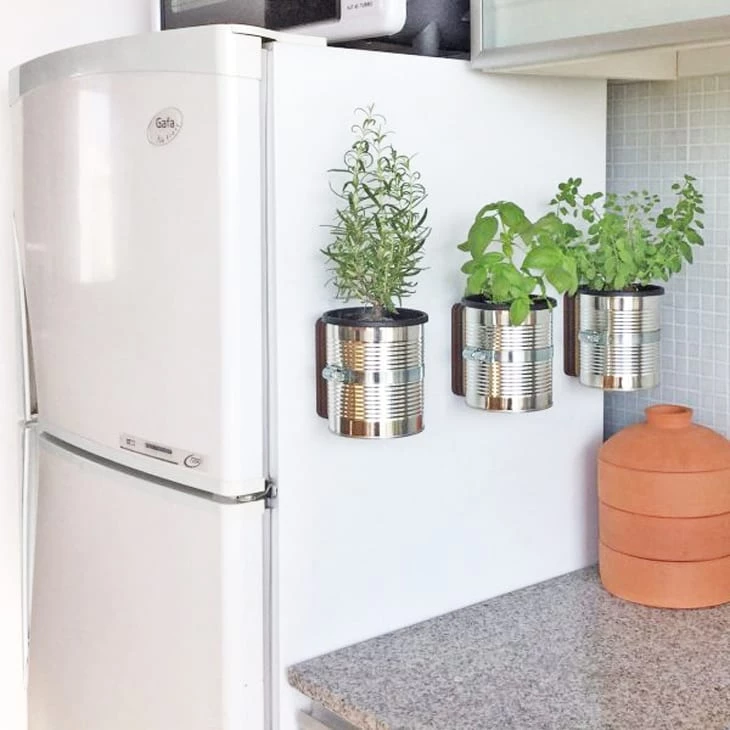
Look at this cool and sustainable idea to have your own vegetable garden in the kitchen! Instead of throwing away milk powder cans, chocolate milk cans, and food cans in general, reuse them to make your own home vegetable garden.
22. crates on the wall
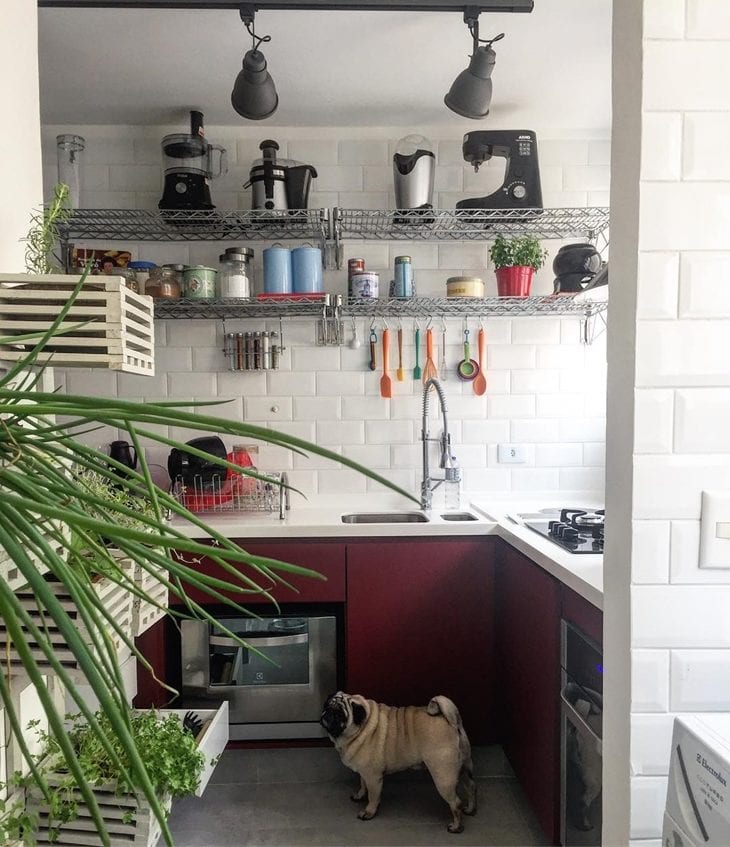
If you like rustic environments, these wooden boxes attached to the wall are a great option to set up your vegetable garden and they support the vegetables well, as well as being very practical and affordable. Look how big the onions got!
23. special tray for the flowerpots
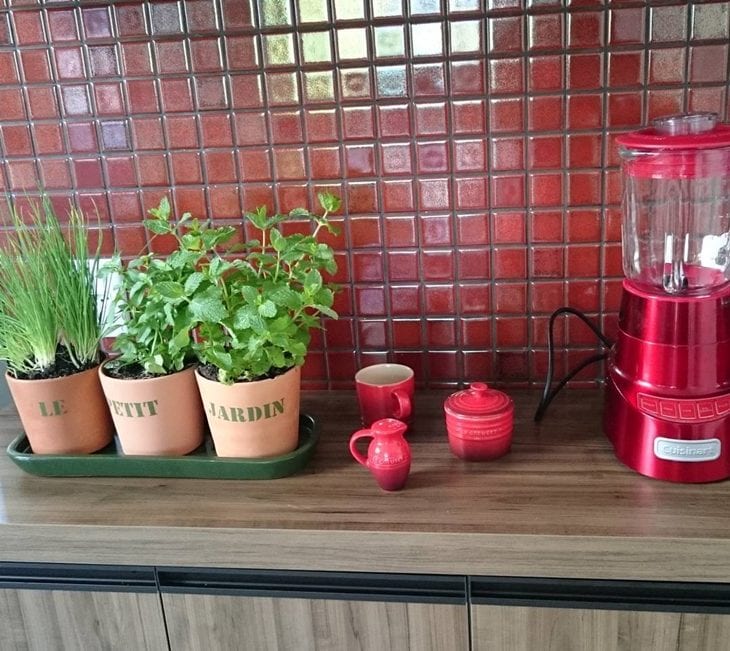
For those who want to innovate in decoration with pots, they can use a tray like this one and make a kind of spice rack. These pots even form a sentence when placed side by side. Besides, they made a beautiful composition with the utensils and appliances on the countertop.
24. run out of wine? plant a vegetable garden
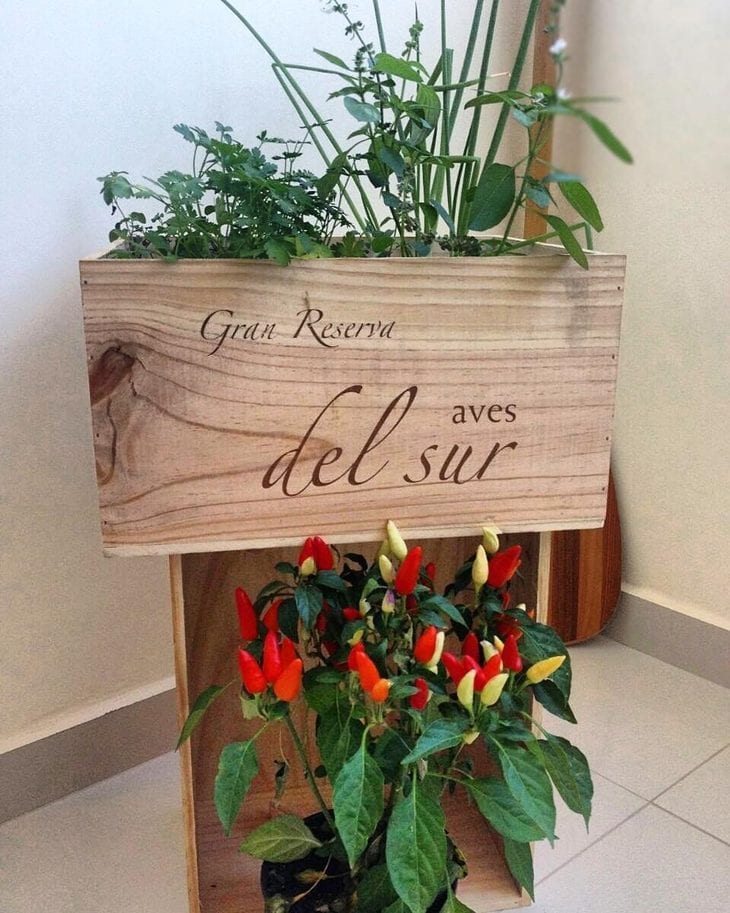
And after the wine is finished, the box from which they came can also become a beautiful support for vegetable gardens. In this case, all the spaces of the box were used: the top for the vegetables and the bottom, exclusively reserved for the peppers. Isn't it beautiful?
25. countertops with niche

In this kitchen, the open niche in the countertop houses an organic vegetable garden and leaves the kitchen completely open and even more charming. Growing a vegetable garden at home is synonymous with health, besides being an extra incentive to include vegetables in the daily diet, with home cultivation you guarantee vegetables completely free of pesticides.
26. modern vertical vegetable garden for stylish kitchens

One more proof that you can combine the planting and cultivation of vegetable gardens with beauty and sophistication in the decoration. but remember that it is vital to follow some care so that the cultivation of your garden is successful from planting to harvesting - and the decoration cannot be above this care.
27. healthy habits and creative decoration
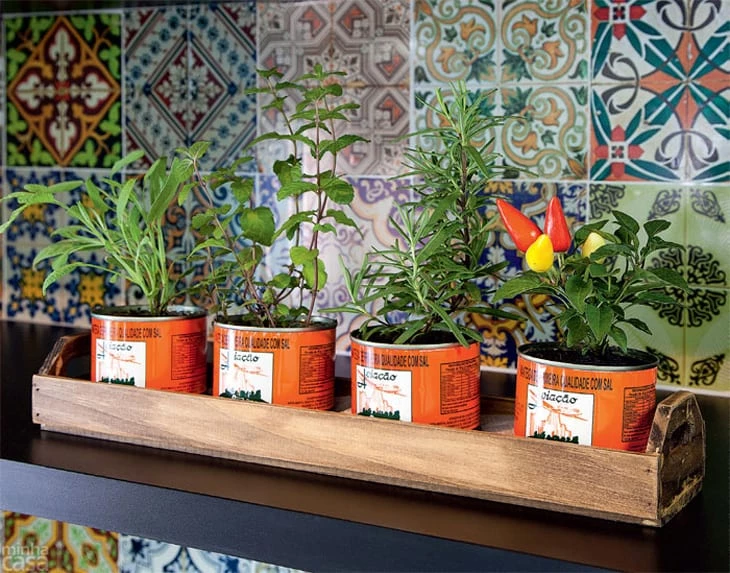
Do you know those empty cans that you don't know how to reuse? Use them to create beautiful pots for your home garden and give more charm to your kitchen. If you want to reproduce the example in the photo, just get a wooden support for them and then place them where you want. The colored cans are especially beautiful. Just don't forget to sanitize the cans before planting them.herbs.
28. to eat fresh
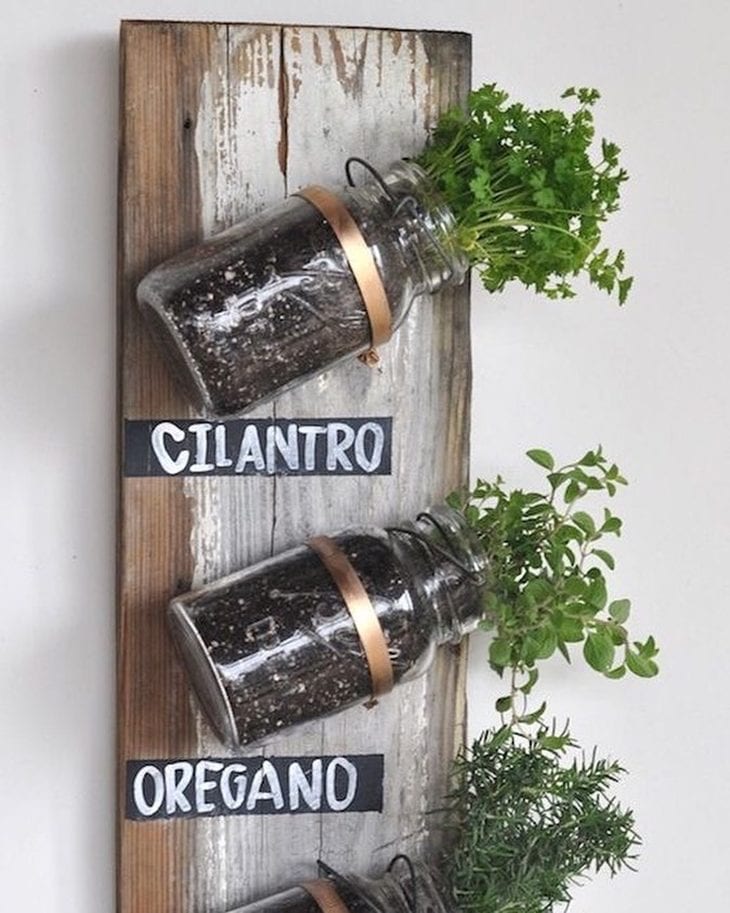
Fresh garden always at hand! There is no place that is not ideal to have a vegetable garden or a mini garden. They are a great way to improve eating habits, since fresh herbs and spices are so good for you. Besides being healthy, it is super charming!
29. vertical vegetable garden with living pockets
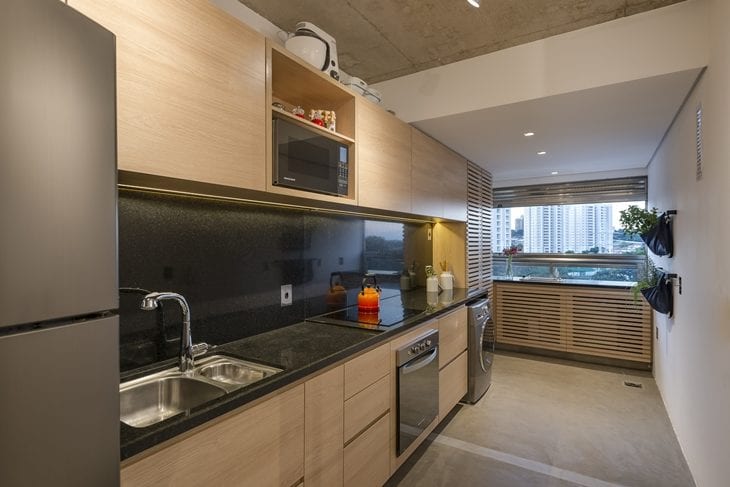
If space is limited, a vertical vegetable garden with living pockets is a great solution. Just put soil underneath and plant the spices. Don't forget that you need sun, water, and lots of care. Water your garden every day, but don't overdo it.
30. another model on the bench
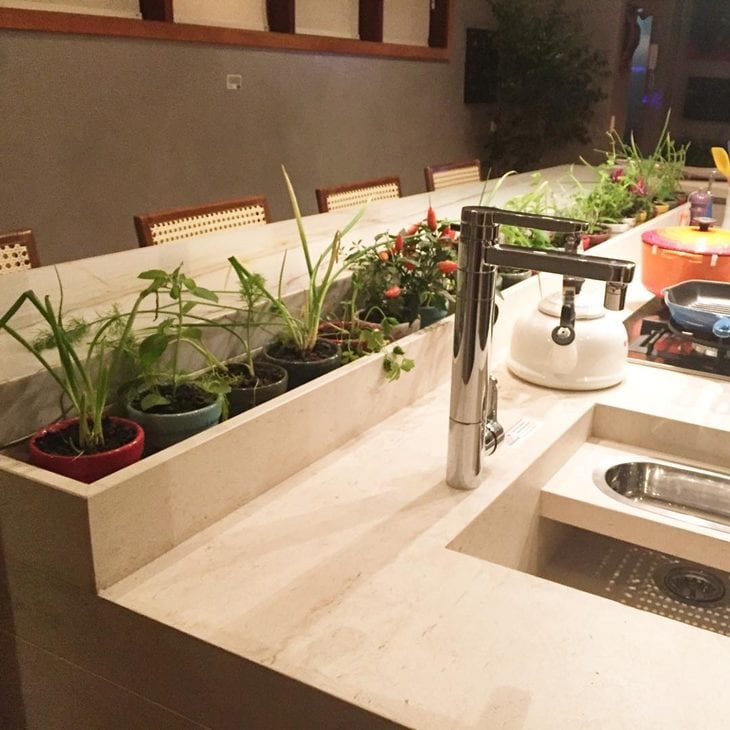
Here, we can see another example of a countertop vegetable garden, which is being used more and more in kitchen projects. However, in this example, they were not planted in a kind of flowerbed, but in colorful and delicate pots. Remembering once again that the place must have plenty of sunlight.
31. the most useful bookcase in the house
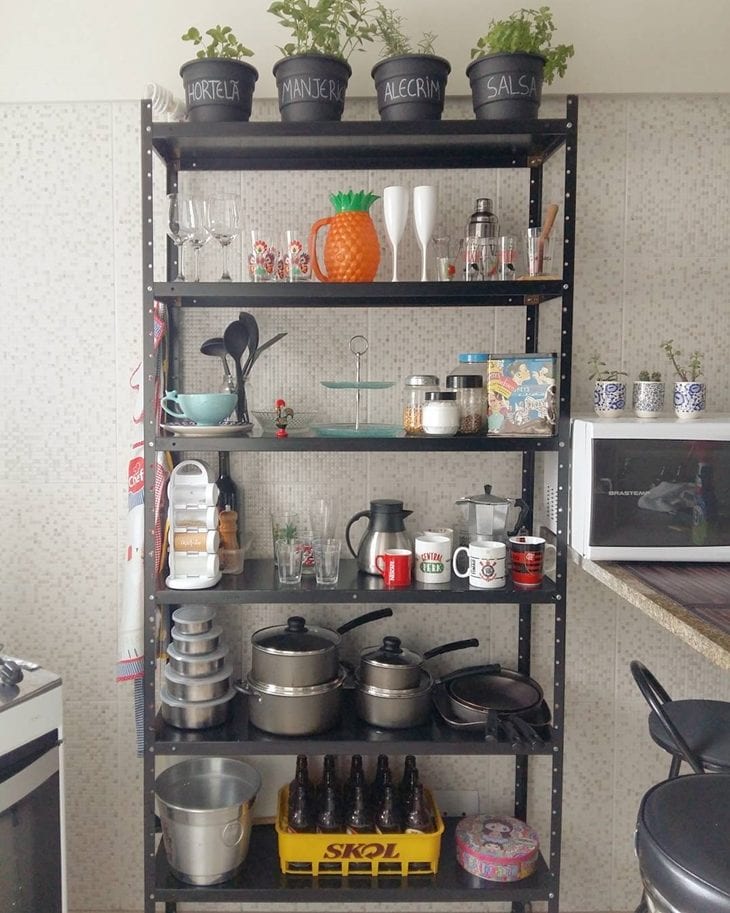
If you have doubts about which spices to plant, remember horticulturist Brenda Pacheco's explanation: "choose the vegetables you like and that best fit the available space in your home.
32. more convenience and comfort
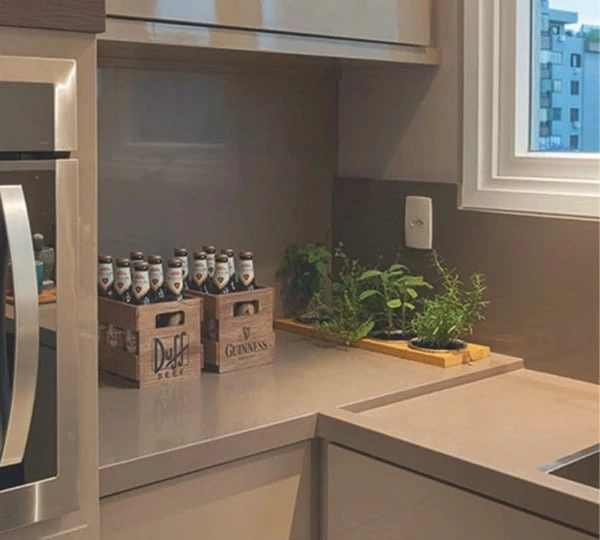
Can you imagine having a vegetable garden close to your preparations? The countertop of this gourmet kitchen was chosen to house the spices and received the installation of a kind of drain for the gardens. Thus, the cultivation happens in the same place, offering practicality and comfort to the residents.
33. near the window
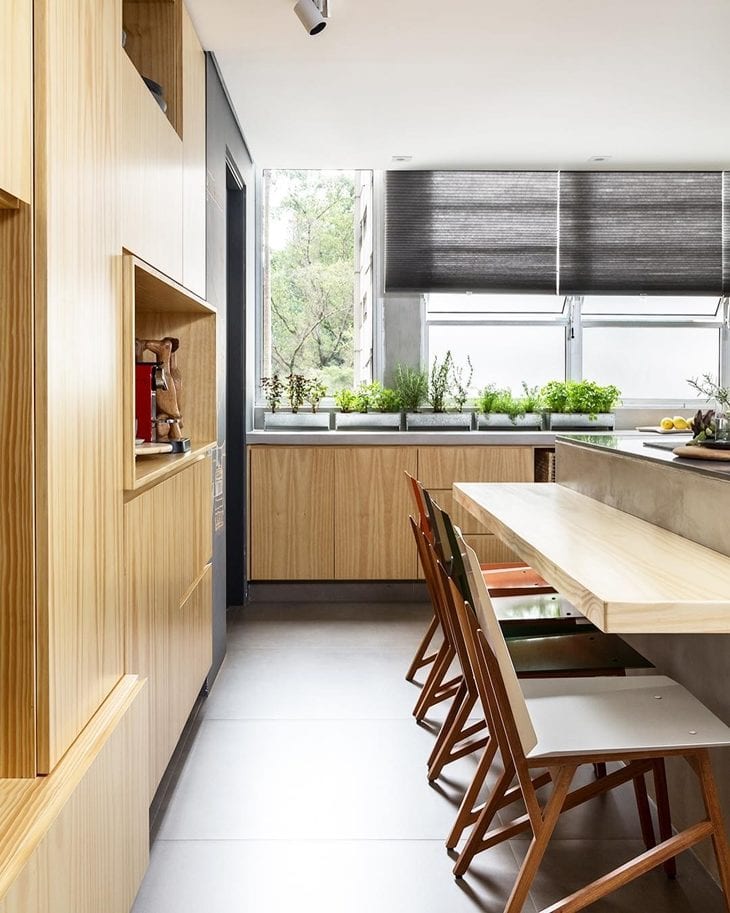
Positioning the garden near a window is one of the best options, due to the incidence of light. The basic conditions for it to work are to have at least four hours of sunlight, adequate fertilization and watering! And of course, a lot of love and dedication.
34. lack of a yard is no reason not to have a vegetable garden

Who needs a backyard when you have a large and beautiful kitchen like this one? Here, the vegetables were given an exclusive countertop with a super functional bed for them to grow beautifully and healthily. The garden in combination with the royal blue tones made the environment more lively and cheerful.
35. ready and full of life garden
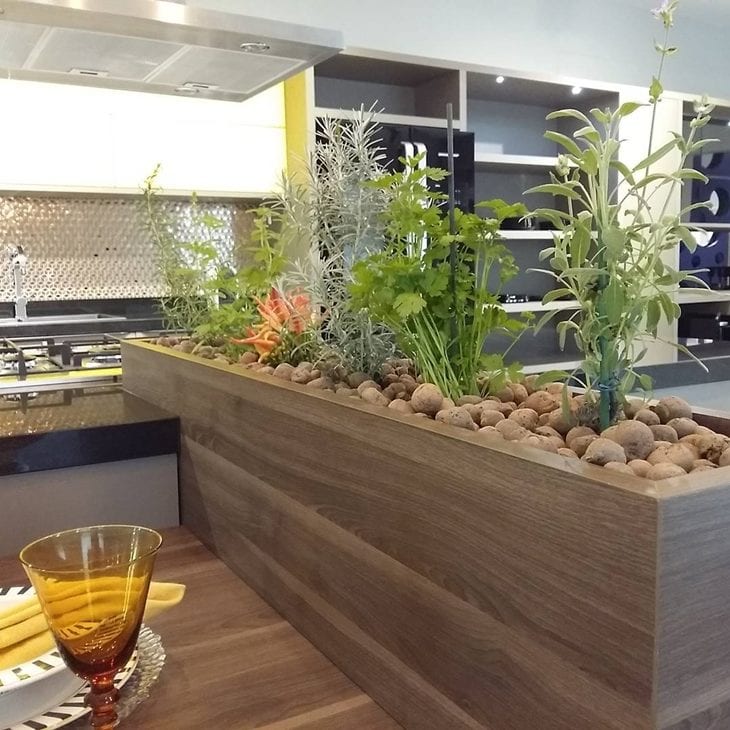
This time, the decoration was on account of the stones, which gave a touch of elegance to the vegetable corner. And they liked it so much that they are growing super lush and robust. We can even see a stuffed carrot plant!
36. simplicity and care
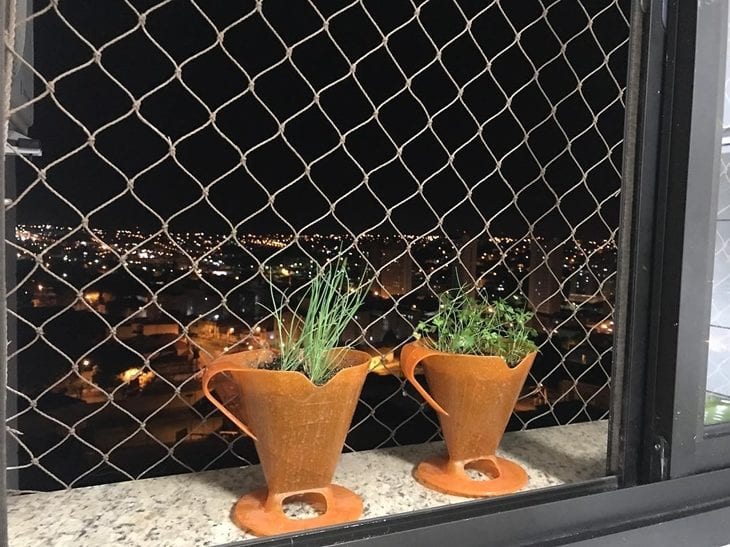
You don't need a lot of fru-fru to have a vegetable garden at home. Here, it was made as simple as possible, and yet it still has its charm. They were also positioned in the window so that the little plants can get the necessary amount of sunlight. And at night they even get a nice cool breeze.
37. an imposing vase
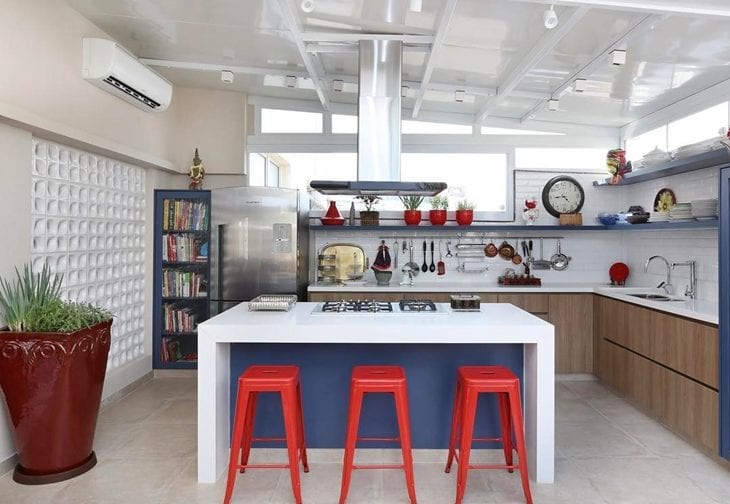
And who said that only the small vases can be used for planting vegetable gardens? You can also use these large vases that are usually used for decorative plants. This way, besides giving it a greater use, you will have a decoration with more personality.
38. self-watering pots are very beneficial
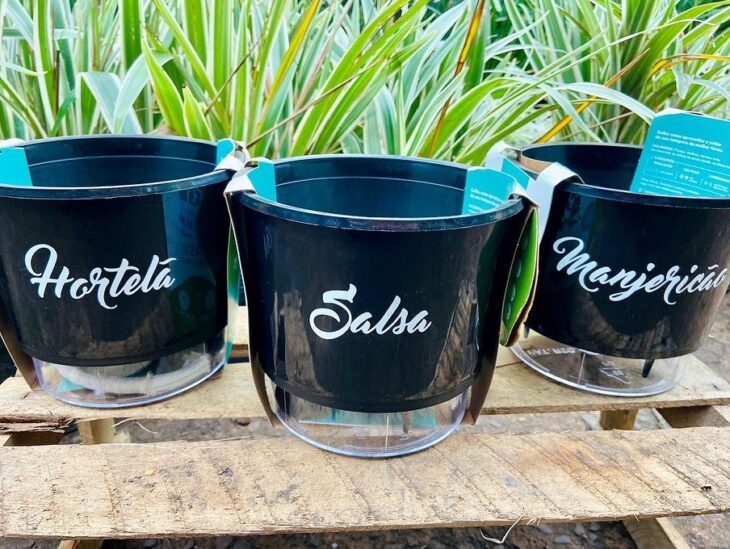
This is one of the models of the famous self-watering pots; besides not needing to water every day, they decorate your house. But remember Brenda's tip for choosing the pot for your vegetable garden: "choose the right pot for your plants, according to their size.
Be sustainable and collaborate with the planet
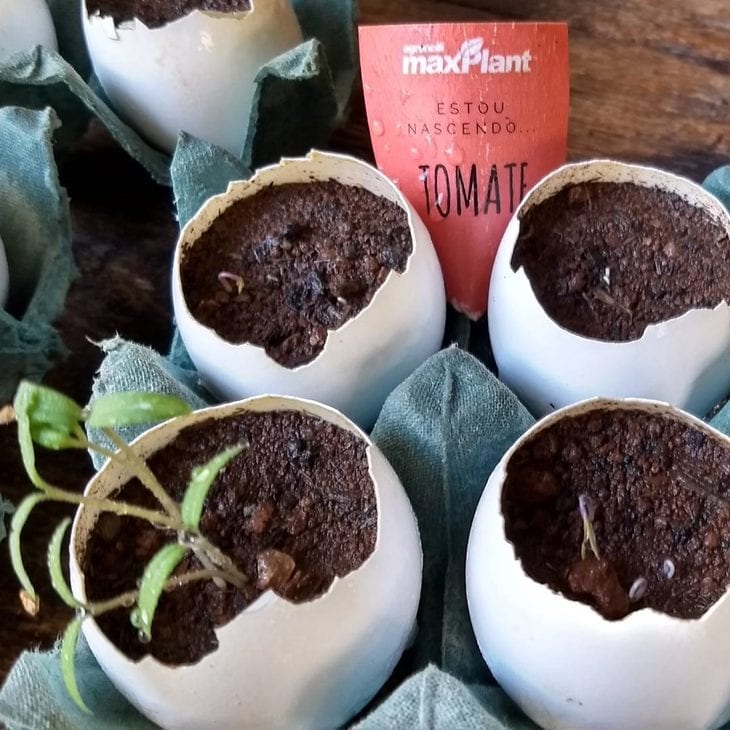
It's hard to believe, but yes, it is possible to plant on eggshells. And to further prove that it is possible, this example shows us little tomato plants at the beginning of germination. This is a very sustainable and creative option to set up your kitchen garden, after all, eggs have everything to do with the decoration of this type of environment. However, it is worth saying that after the plant reaches 10 cm, it is time to start planting.Incredible, isn't it? The little shells are stronger than we think!
40. simple and delicate
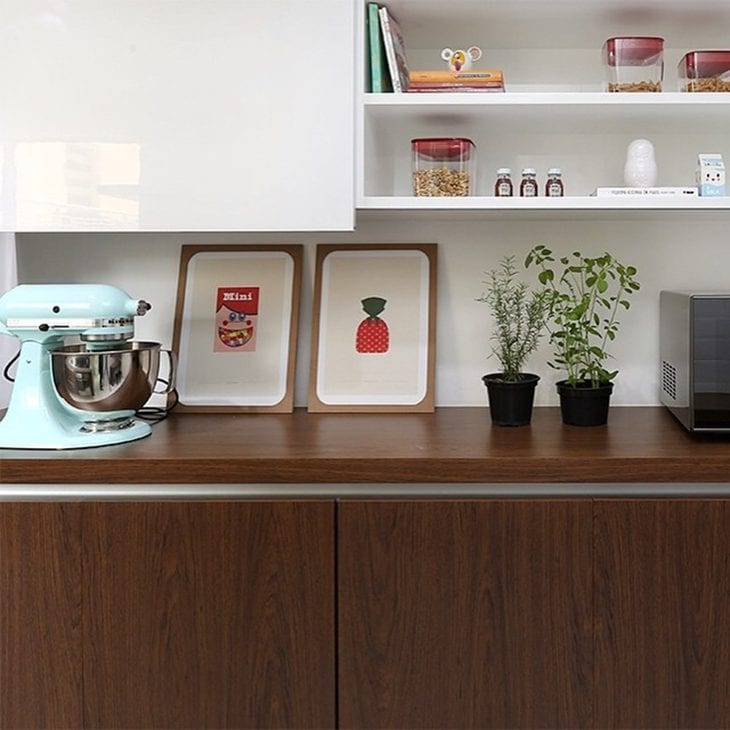
Here, the pots are also super simple and, even so, very charming, giving a touch of delicacy to the decoration. Notice that people usually use a pot for each spice. This is important, because not all vegetables get along well together. Consult a specialist or study a lot before putting plants of different species in the same pot.
41. modern kitchen with small vegetable garden
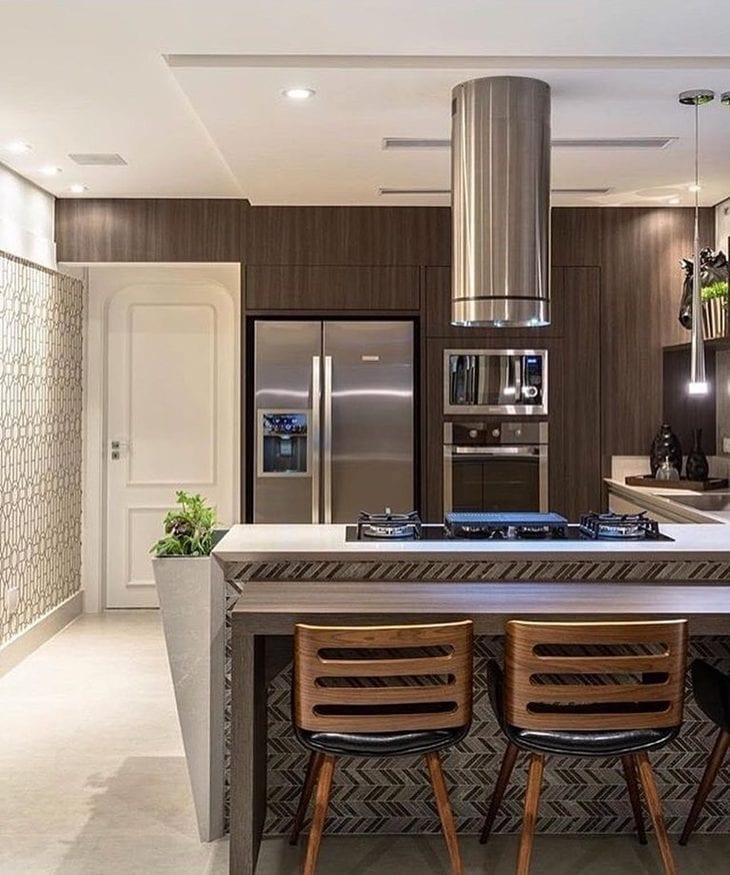
In this beautiful kitchen with dark tones and more intimate, the vegetable garden was set up in a place that looks more like a trashcan on the countertop. Let's face it, the vegetable garden in place of the trashcan, besides being creative, looks and smells much nicer, doesn't it?
42. vases on the wall are pure charm
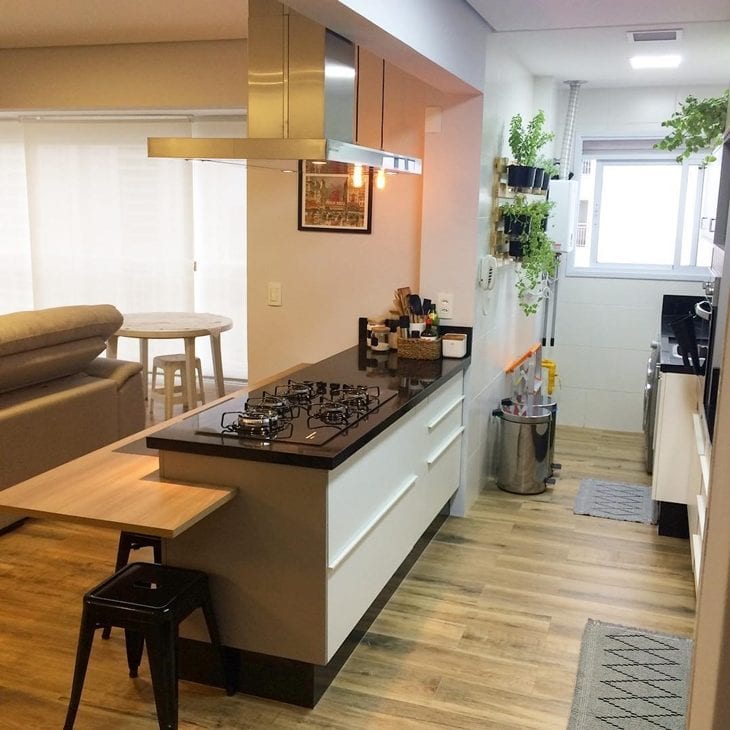
Here we see another option of pots stuck on the walls, and the hidden corner of the kitchen got a special touch with the vegetables. Dedicating a little time to growing these plants, besides providing a tastier and healthier diet, also provides a relaxing activity of interaction with nature.
43. home gardens can also be educational
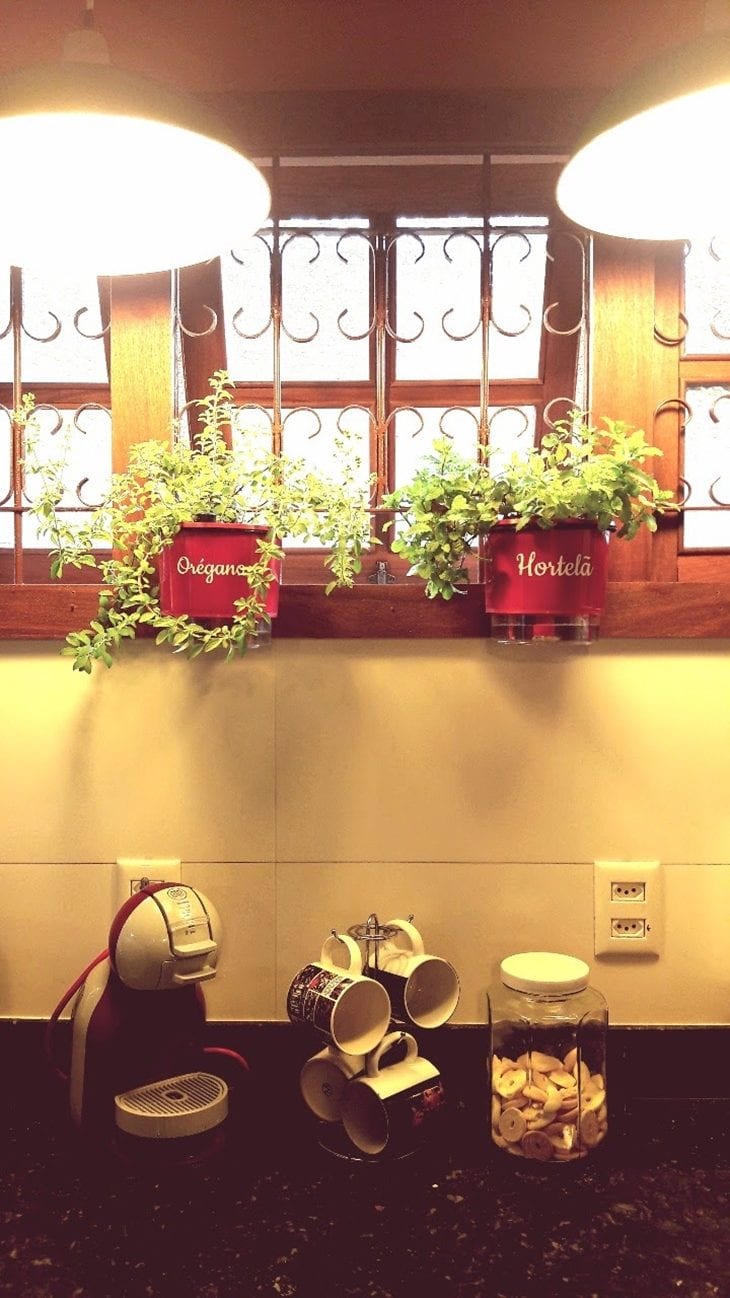
Besides all the benefits we have already mentioned, the home garden as a benefit of healthy eating can be an even more valuable appeal to children. Taking care of the garden can be a good activity to be developed with the family, providing more time with the children, helping to teach lessons of responsibility, and providing contact with nature.
44. vegetable garden on top of the cabinet
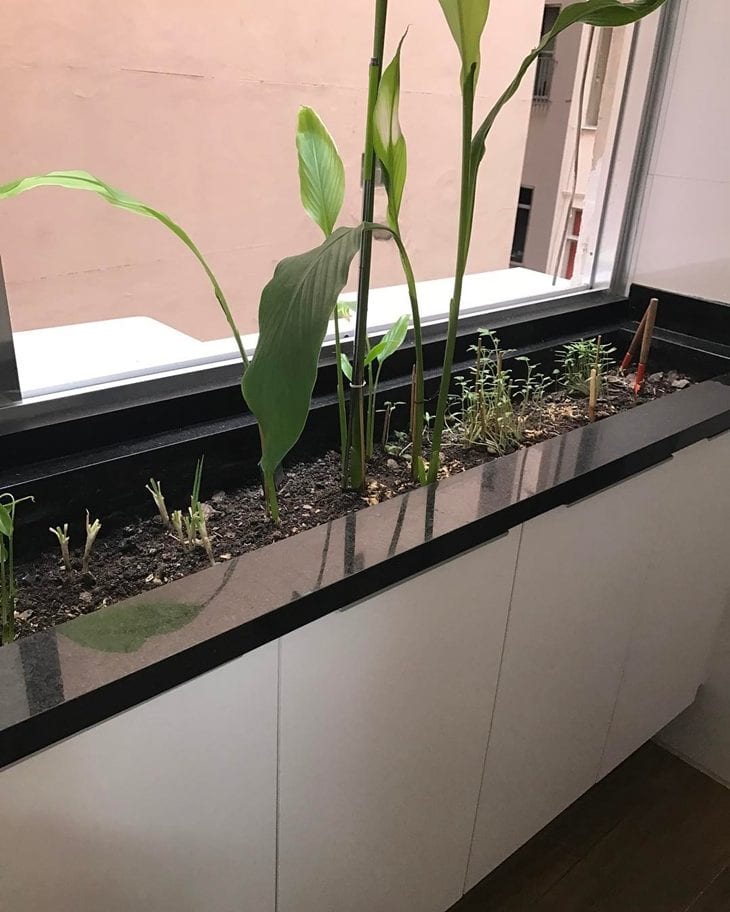
The home vegetable garden has been increasingly requested in architectural projects. In this example, the vegetable garden was made with a cabinet under the countertop, optimizing and making the most of the spaces. We can notice once again the proximity of the window, which is great for the plants' health.
45. a picture full of life
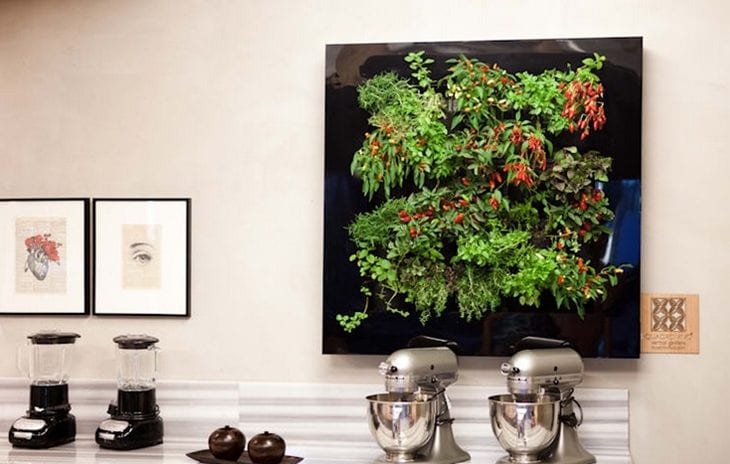
Have you ever heard of green frames? These are frames decorated with real plants, which have computerized structures that control the water level in the reservoir. This can be a good alternative to bring a small spice and herb garden into the kitchen and still decorate the environment.
46. a project that is pure sustainability
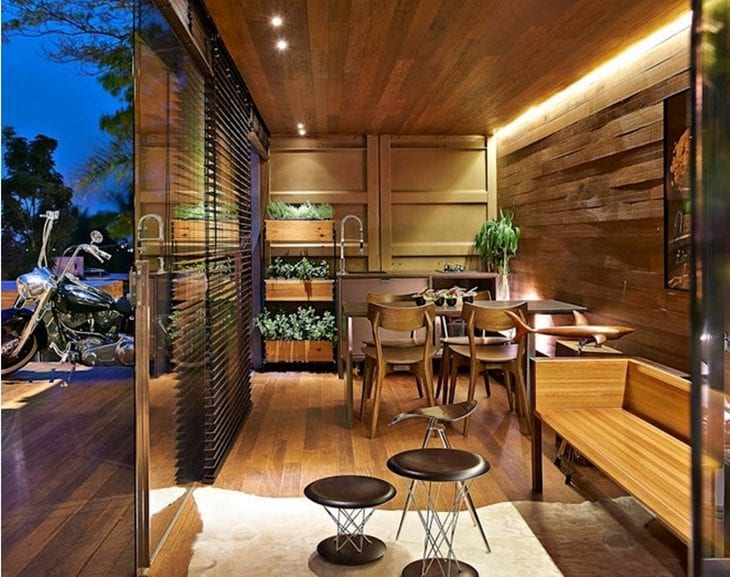
This beautiful rustic house is compact and sustainable, made from a container that has been converted into a house. The kitchen has a steel shelf with three wooden plant pot holders, allowing the owner to grow vegetables, spices, herbs, and condiments in general.
47. and the spring onion grows beautifully
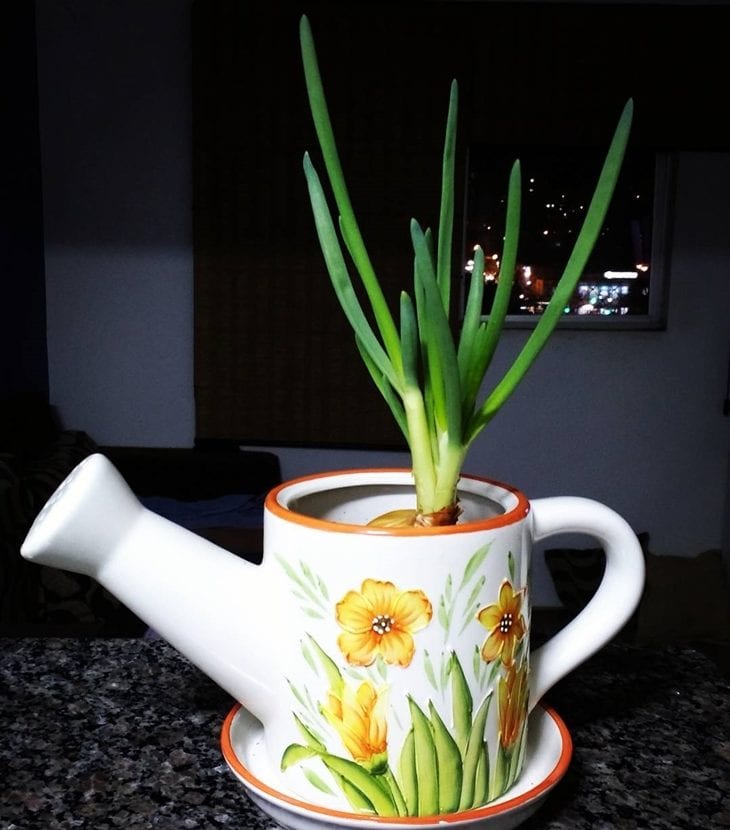
If you live in an apartment, all you have to do is provide tin cans, vases, bottles, or flower pots to start planting. Here, a mini watering can was used to plant the chives. This composition looks very interesting, since the watering can has everything to do with the planting theme.
48. panel with pots for the vegetables
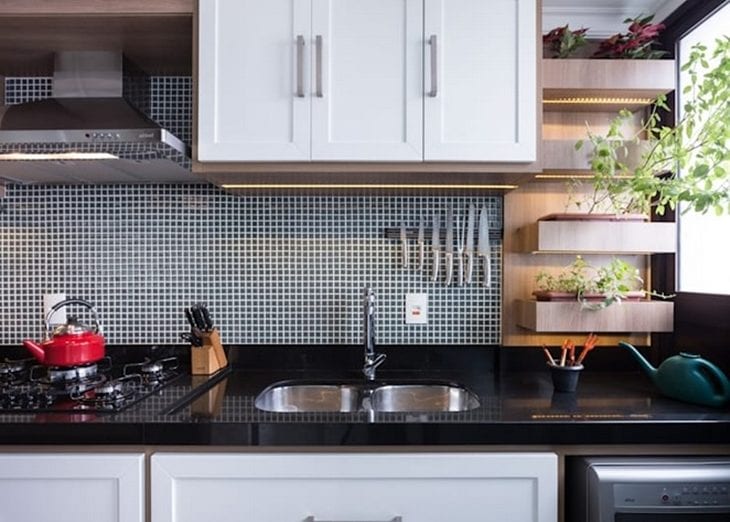
In this kitchen, we see another option of panel with shelves that can be used to plant home gardens. The project has a wooden panel with four vertical pot holders, located right next to the window. Besides being practical and efficient, the composition is even more modern with built-in LED lights.
49. ice cream sticks are more useful than you think
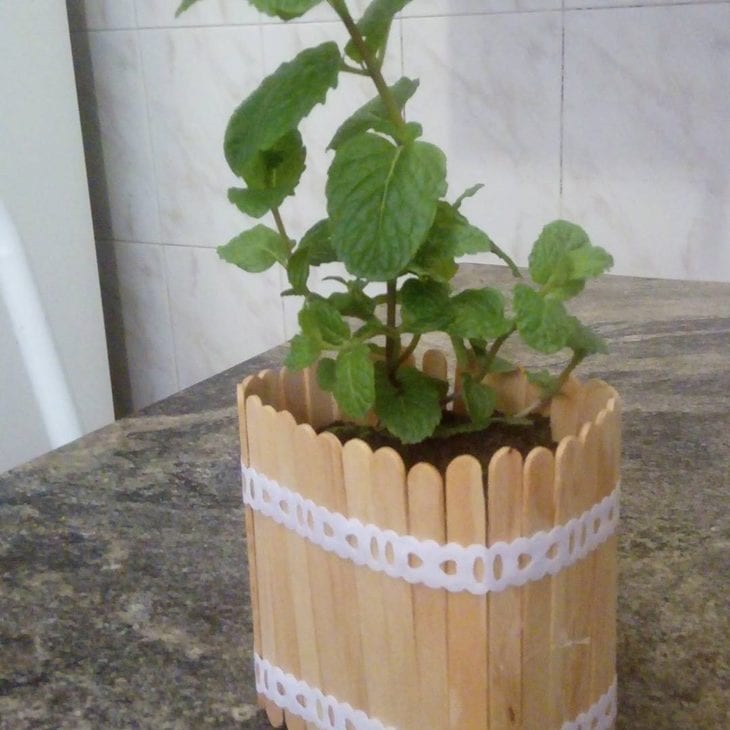
Another sustainable option that serves to reuse materials is to use those classic popsicle sticks to make an authentic and unique pot for your plants. You can also decorate them with ribbons, jute, fabrics, lace, and even paint the sticks. It's so cute!
50. ready-to-eat, pesticide-free vegetables

One of the advantages of home gardening is that we know exactly how the food was grown and we can be sure that no chemicals were used at any stage. When planted in the kitchen, the advantages are even greater because the spices are already there close to us and can be handled more practically and quickly during food preparation.
Then start right now to enjoy the benefits of having a vegetable garden in your kitchen! Inspire yourself with these ideas to venture into this pleasurable activity and always have fresh spices, fruits and vegetables at your disposal.And to start your own, see suggestions for spices to plant at home.


